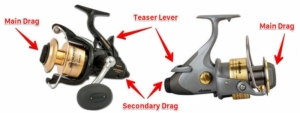DAIWA EMCAST® BR BITE N’ RUN REELS:
Emcast Bite and Run series will let them run until you flip it in gear than with Ultimate Tournament rear drag you have the stopping power to reel them in.
FEATURES of THE DAIWA EMCAST® BR BITE N’ RUN REEL:
- Lightweight composite body, side cover and rotor;
- 8 Bearing System (7BB + 1RB);
- Machined cut aluminum handle;
- Air Bail®;
- Ultimate Tournament Carbon Drag (UTD) with 22 lbs Drag Max.
See here for other Daiwa products we inventory.
See here for other Baitrunner Spinning reels we inventory.
Baitrunner Spinning Reels Explained …
By the Salted Angler
What is a Baitrunner Spinning Reel?
So what is this reel they call a Baitrunner or Free Spool as some refer to it all about? If you are not familiar with the Baitrunner reel, then let me explain.
They are used when you want to fish with either live or cut bait and want to allow the fish to be able to take the bait and “run” with it before the hook is set.
The Baitrunner was first introduced to the market by Shimano in 1987 and Shimano trademarked the name Baitrunner. Other common names for this style of reel are:
- Free Spool
- Live Liner
- Bait feeder
- Bite-n-Run
A Baitrunner reel is designed with both a primary and a secondary drag system.
A Baitrunner reel has what is called a “teaser lever” to engage the secondary drag system. When the secondary drag is engaged you create what we call a “controlled free spool,” meaning that the drag is light enough to allow a fish to take the bait and run with it without feeling the very light drag.
The secondary drag is typically adjusted with a drag knob located on the bottom of the reel and only offers a few pounds of drag or tension. This secondary drag is only designed to keep the reel from unspooling and to allow the bait to swim freely.
Once a fish takes the bait and starts to swim with it, the reel will allow the line to come off the spool very easily — remember there are only 1 or 2 pounds of drag on the reel at this time.
Now all you have to do is pick up your rod and wind the handle a single turn in most cases and that will disengage the secondary drag system so that the main drag can take over and you can set the hook.
The advantage of the Baitrunner is that it allows you to fish live-lined bait without having to adjust the main drag or flip the bail and hope that too much line falls off the spool and makes a tangled mess.
When to Use a Baitrunner:
Baitrunners are often used by freshwater fishermen for species such as carp and catfish when fishing chunk bait. In fact, when the Baitrunner reel was first introduced back in 1987, it was the UK carp fishermen that were the early adopters of this new technology.
In the world of saltwater fishing, you will most often be considering the use of a Baitrunner reel when surf casting or inshore fishing from land for bottom feeding fish, or fishing from a boat for reef fish like snapper or grouper.
A major advantage of the Baitrunner is that it will allow you to fish multiple rods at the same time. Since a fish can take your bait and run with it with some tension on the line, then you can then easily pick your rod up from the sand spike or rod holder and then proceed to set the hook.
How to Use a Baitrunner Spinning Reel:
The primary difference between a conventional spinning reel and a Baitrunner spinning reel is the secondary drag system. The secondary drag is also referred to as the rear drag on most of the Baitrunner style reels.
You want to set the secondary or rear drag to a very light setting that is just enough to keep enough tension on the line to keep it from getting tangled, but light enough that a fish can take the bait and run with it without getting spooked.
The strength of the current where you are fishing is going to be a factor in how much tension you place on the drag. Once you have cast the bait, the spool continues to let line out very slowly and then you will need to tighten the drag a click or two at a time until no more line is being let out.
 Once the fish is running with the bait then you need to set the hook. Typically I count 4-5 seconds before I set the hook as I want the fish to have a good opportunity to get the bait fully in its mouth.
Once the fish is running with the bait then you need to set the hook. Typically I count 4-5 seconds before I set the hook as I want the fish to have a good opportunity to get the bait fully in its mouth.
The last thing you want to do is to set the hook too quickly and rip the bait from the fish’s mouth. Remember the fish has no idea that there is a line attached to the bait as the drag is so light.
As far as a hook choice goes, I typically will use a circle hook as they will set themselves and then the timing of the hook set is really not so important.
With that said, I still like to give the fish 4-5 seconds to make sure that they have the entire bait in their mouth.
Pros:
- Best for live bait;
- Fish multiple rods.
Cons:
- 2 drags to maintain
Conclusion:
If you have decided that your style of fishing is going to include fishing with live baits then I would highly recommend that you get a Baitrunner style reel in your hands and try fishing with it.
Most people that use a Baitrunner and have been taught how to use it properly swear by them. I have some friends that based on the type of fishing they do will not use a reel that does not include a dual drag system.
Contact Us for current inventory and ordering details.
Related Products
 https://hooklineandsinker.ca/wp-content/uploads/2022/05/Redington-Euro-Nymph-Kit-3100-4-scaled.jpeg
2560
2560
HLSAdmin
https://hooklineandsinker.ca/wp-content/uploads/2014/12/Steelheading-in-the-Snow-900-80-Not-Faded-Actual-1030x91.jpg
HLSAdmin2022-05-08 22:37:312022-05-08 23:14:11Redington Euro Nymph Field Kit
https://hooklineandsinker.ca/wp-content/uploads/2022/05/Redington-Euro-Nymph-Kit-3100-4-scaled.jpeg
2560
2560
HLSAdmin
https://hooklineandsinker.ca/wp-content/uploads/2014/12/Steelheading-in-the-Snow-900-80-Not-Faded-Actual-1030x91.jpg
HLSAdmin2022-05-08 22:37:312022-05-08 23:14:11Redington Euro Nymph Field Kit https://hooklineandsinker.ca/wp-content/uploads/2021/07/Shimano-Curado-MGL-150.jpg
702
936
HLSAdmin
https://hooklineandsinker.ca/wp-content/uploads/2014/12/Steelheading-in-the-Snow-900-80-Not-Faded-Actual-1030x91.jpg
HLSAdmin2021-07-20 19:28:182021-07-20 19:28:18Shimano Curado MGL 150 Baitcast Reel
https://hooklineandsinker.ca/wp-content/uploads/2021/07/Shimano-Curado-MGL-150.jpg
702
936
HLSAdmin
https://hooklineandsinker.ca/wp-content/uploads/2014/12/Steelheading-in-the-Snow-900-80-Not-Faded-Actual-1030x91.jpg
HLSAdmin2021-07-20 19:28:182021-07-20 19:28:18Shimano Curado MGL 150 Baitcast Reel https://hooklineandsinker.ca/wp-content/uploads/2021/03/Daiwa-Technology-Monocoque-Reel-Bodies-B.jpg
451
468
HLSAdmin
https://hooklineandsinker.ca/wp-content/uploads/2014/12/Steelheading-in-the-Snow-900-80-Not-Faded-Actual-1030x91.jpg
HLSAdmin2021-03-28 23:15:412021-03-29 18:28:58Daiwa Technology: Monocoque Reel Bodies
https://hooklineandsinker.ca/wp-content/uploads/2021/03/Daiwa-Technology-Monocoque-Reel-Bodies-B.jpg
451
468
HLSAdmin
https://hooklineandsinker.ca/wp-content/uploads/2014/12/Steelheading-in-the-Snow-900-80-Not-Faded-Actual-1030x91.jpg
HLSAdmin2021-03-28 23:15:412021-03-29 18:28:58Daiwa Technology: Monocoque Reel Bodies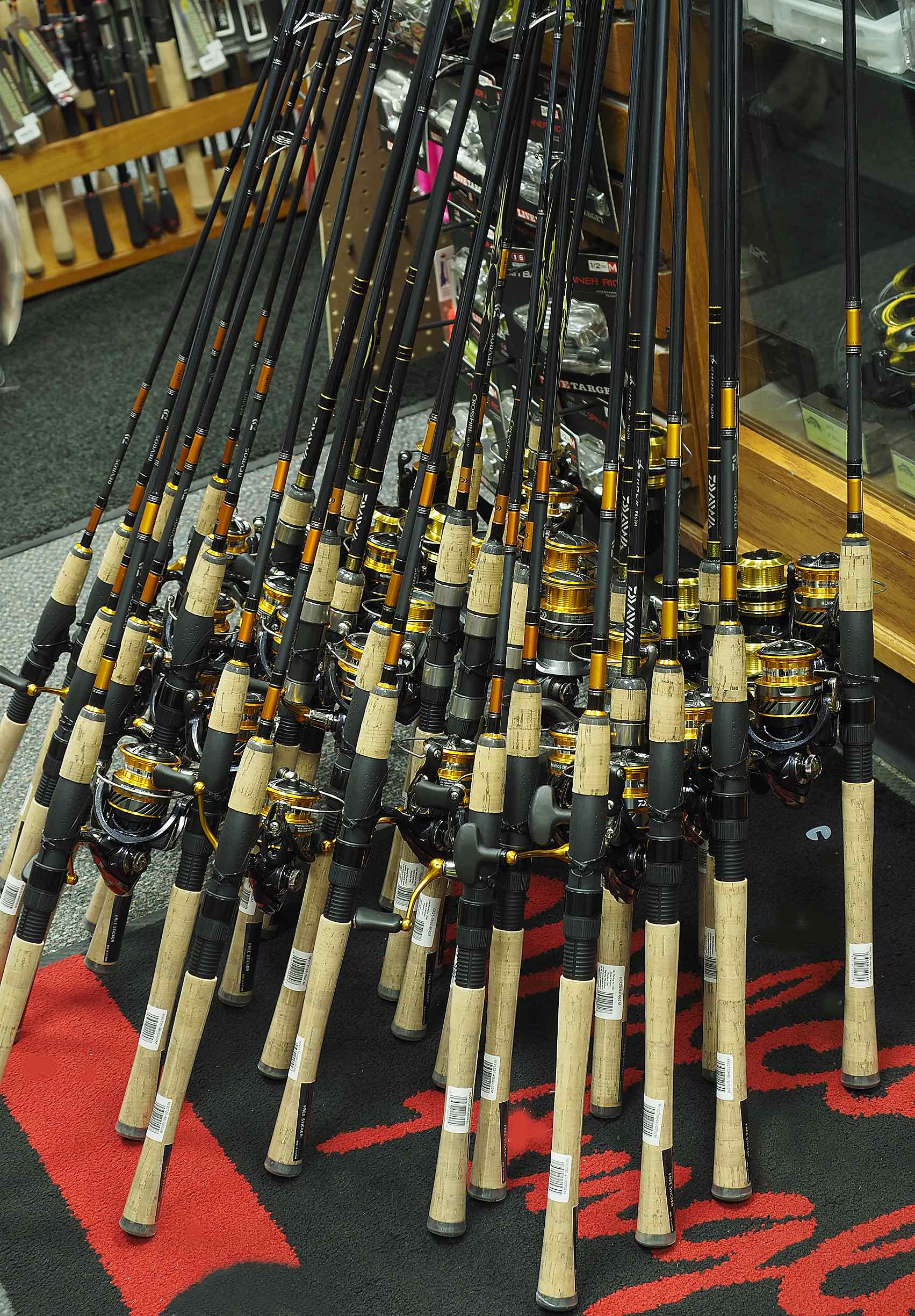 https://hooklineandsinker.ca/wp-content/uploads/2019/09/Daiwa-Rod-and-Reel-Combos-AA.jpg
2450
1703
HLSAdmin
https://hooklineandsinker.ca/wp-content/uploads/2014/12/Steelheading-in-the-Snow-900-80-Not-Faded-Actual-1030x91.jpg
HLSAdmin2019-09-01 17:24:432019-09-01 18:15:00Fishing Rod and Reel Combos
https://hooklineandsinker.ca/wp-content/uploads/2019/09/Daiwa-Rod-and-Reel-Combos-AA.jpg
2450
1703
HLSAdmin
https://hooklineandsinker.ca/wp-content/uploads/2014/12/Steelheading-in-the-Snow-900-80-Not-Faded-Actual-1030x91.jpg
HLSAdmin2019-09-01 17:24:432019-09-01 18:15:00Fishing Rod and Reel Combos https://hooklineandsinker.ca/wp-content/uploads/2015/08/Shimano-Spinning-and-Baitcaster-Spare-Spools-AA.jpg
1064
2078
HLSAdmin
https://hooklineandsinker.ca/wp-content/uploads/2014/12/Steelheading-in-the-Snow-900-80-Not-Faded-Actual-1030x91.jpg
HLSAdmin2015-08-06 23:49:452019-04-19 17:28:23Spare Spools – Current or Vintage Spinning Reels
https://hooklineandsinker.ca/wp-content/uploads/2015/08/Shimano-Spinning-and-Baitcaster-Spare-Spools-AA.jpg
1064
2078
HLSAdmin
https://hooklineandsinker.ca/wp-content/uploads/2014/12/Steelheading-in-the-Snow-900-80-Not-Faded-Actual-1030x91.jpg
HLSAdmin2015-08-06 23:49:452019-04-19 17:28:23Spare Spools – Current or Vintage Spinning Reels https://hooklineandsinker.ca/wp-content/uploads/2020/07/Shimano-Vanford-B.png
476
392
HLSAdmin
https://hooklineandsinker.ca/wp-content/uploads/2014/12/Steelheading-in-the-Snow-900-80-Not-Faded-Actual-1030x91.jpg
HLSAdmin2020-07-10 21:06:562021-07-20 20:10:08Shimano Vanford
https://hooklineandsinker.ca/wp-content/uploads/2020/07/Shimano-Vanford-B.png
476
392
HLSAdmin
https://hooklineandsinker.ca/wp-content/uploads/2014/12/Steelheading-in-the-Snow-900-80-Not-Faded-Actual-1030x91.jpg
HLSAdmin2020-07-10 21:06:562021-07-20 20:10:08Shimano Vanford https://hooklineandsinker.ca/wp-content/uploads/2020/12/Shimano-Curado-300-and-301-Baitcasting-Reel.png
508
600
HLSAdmin
https://hooklineandsinker.ca/wp-content/uploads/2014/12/Steelheading-in-the-Snow-900-80-Not-Faded-Actual-1030x91.jpg
HLSAdmin2020-12-26 22:06:362020-12-26 22:06:36Shimano Curado 300 & 301 Baitcasting Reel
https://hooklineandsinker.ca/wp-content/uploads/2020/12/Shimano-Curado-300-and-301-Baitcasting-Reel.png
508
600
HLSAdmin
https://hooklineandsinker.ca/wp-content/uploads/2014/12/Steelheading-in-the-Snow-900-80-Not-Faded-Actual-1030x91.jpg
HLSAdmin2020-12-26 22:06:362020-12-26 22:06:36Shimano Curado 300 & 301 Baitcasting Reel https://hooklineandsinker.ca/wp-content/uploads/2020/10/Daiwa-PCNALT4000D.png
422
500
HLSAdmin
https://hooklineandsinker.ca/wp-content/uploads/2014/12/Steelheading-in-the-Snow-900-80-Not-Faded-Actual-1030x91.jpg
HLSAdmin2020-10-12 15:37:432020-10-12 15:37:43Daiwa Procyon AL Spinning Reel Family
https://hooklineandsinker.ca/wp-content/uploads/2020/10/Daiwa-PCNALT4000D.png
422
500
HLSAdmin
https://hooklineandsinker.ca/wp-content/uploads/2014/12/Steelheading-in-the-Snow-900-80-Not-Faded-Actual-1030x91.jpg
HLSAdmin2020-10-12 15:37:432020-10-12 15:37:43Daiwa Procyon AL Spinning Reel Family https://hooklineandsinker.ca/wp-content/uploads/2020/09/Daiwa-Tatula-CT-Baitast-Reel-A.png
682
936
HLSAdmin
https://hooklineandsinker.ca/wp-content/uploads/2014/12/Steelheading-in-the-Snow-900-80-Not-Faded-Actual-1030x91.jpg
HLSAdmin2020-09-18 21:45:342020-09-18 21:49:21Daiwa Tatula CT Baitcast Reel
https://hooklineandsinker.ca/wp-content/uploads/2020/09/Daiwa-Tatula-CT-Baitast-Reel-A.png
682
936
HLSAdmin
https://hooklineandsinker.ca/wp-content/uploads/2014/12/Steelheading-in-the-Snow-900-80-Not-Faded-Actual-1030x91.jpg
HLSAdmin2020-09-18 21:45:342020-09-18 21:49:21Daiwa Tatula CT Baitcast Reel https://hooklineandsinker.ca/wp-content/uploads/2020/08/Daiwa-Laguna-LT-Spinning-Reel-A.jpg
854
936
HLSAdmin
https://hooklineandsinker.ca/wp-content/uploads/2014/12/Steelheading-in-the-Snow-900-80-Not-Faded-Actual-1030x91.jpg
HLSAdmin2020-08-17 19:19:552020-08-17 19:19:55Daiwa Laguna LT Spinning Reel
https://hooklineandsinker.ca/wp-content/uploads/2020/08/Daiwa-Laguna-LT-Spinning-Reel-A.jpg
854
936
HLSAdmin
https://hooklineandsinker.ca/wp-content/uploads/2014/12/Steelheading-in-the-Snow-900-80-Not-Faded-Actual-1030x91.jpg
HLSAdmin2020-08-17 19:19:552020-08-17 19:19:55Daiwa Laguna LT Spinning Reel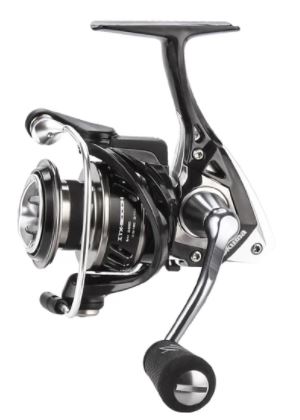 https://hooklineandsinker.ca/wp-content/uploads/2021/02/Okuma-ITX-Reel.jpg
420
300
HLSAdmin
https://hooklineandsinker.ca/wp-content/uploads/2014/12/Steelheading-in-the-Snow-900-80-Not-Faded-Actual-1030x91.jpg
HLSAdmin2021-02-28 14:33:042022-01-05 15:55:27Okuma ITX Carbon Spinning Reel
https://hooklineandsinker.ca/wp-content/uploads/2021/02/Okuma-ITX-Reel.jpg
420
300
HLSAdmin
https://hooklineandsinker.ca/wp-content/uploads/2014/12/Steelheading-in-the-Snow-900-80-Not-Faded-Actual-1030x91.jpg
HLSAdmin2021-02-28 14:33:042022-01-05 15:55:27Okuma ITX Carbon Spinning Reel https://hooklineandsinker.ca/wp-content/uploads/2020/06/13-Fishing-Creed-K-A.jpg
300
300
HLSAdmin
https://hooklineandsinker.ca/wp-content/uploads/2014/12/Steelheading-in-the-Snow-900-80-Not-Faded-Actual-1030x91.jpg
HLSAdmin2020-06-23 21:57:112020-09-29 22:51:1813 Fishing Creed K
https://hooklineandsinker.ca/wp-content/uploads/2020/06/13-Fishing-Creed-K-A.jpg
300
300
HLSAdmin
https://hooklineandsinker.ca/wp-content/uploads/2014/12/Steelheading-in-the-Snow-900-80-Not-Faded-Actual-1030x91.jpg
HLSAdmin2020-06-23 21:57:112020-09-29 22:51:1813 Fishing Creed K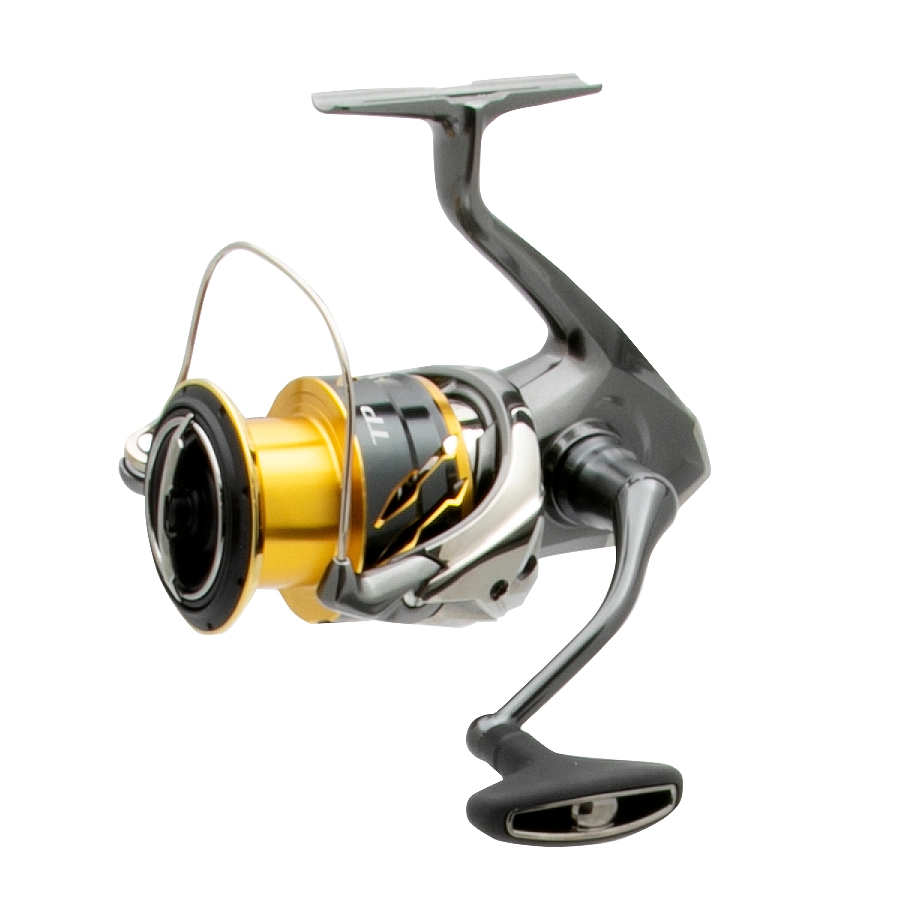 https://hooklineandsinker.ca/wp-content/uploads/2020/04/Shimano-Twin-Poer-FD-P-TWIN_POWER_FD_01.jpg
924
911
HLSAdmin
https://hooklineandsinker.ca/wp-content/uploads/2014/12/Steelheading-in-the-Snow-900-80-Not-Faded-Actual-1030x91.jpg
HLSAdmin2020-04-20 21:12:282020-04-20 21:21:28Shimano Twin Power HD
https://hooklineandsinker.ca/wp-content/uploads/2020/04/Shimano-Twin-Poer-FD-P-TWIN_POWER_FD_01.jpg
924
911
HLSAdmin
https://hooklineandsinker.ca/wp-content/uploads/2014/12/Steelheading-in-the-Snow-900-80-Not-Faded-Actual-1030x91.jpg
HLSAdmin2020-04-20 21:12:282020-04-20 21:21:28Shimano Twin Power HD https://hooklineandsinker.ca/wp-content/uploads/2021/01/Shimano-Ultegra-Spinning-Reel-ULTEGRA-FC-primary_aleft.jpg
1500
1500
HLSAdmin
https://hooklineandsinker.ca/wp-content/uploads/2014/12/Steelheading-in-the-Snow-900-80-Not-Faded-Actual-1030x91.jpg
HLSAdmin2021-01-26 21:43:212022-01-05 15:55:39Shimano Ultegra Spinning Reel
https://hooklineandsinker.ca/wp-content/uploads/2021/01/Shimano-Ultegra-Spinning-Reel-ULTEGRA-FC-primary_aleft.jpg
1500
1500
HLSAdmin
https://hooklineandsinker.ca/wp-content/uploads/2014/12/Steelheading-in-the-Snow-900-80-Not-Faded-Actual-1030x91.jpg
HLSAdmin2021-01-26 21:43:212022-01-05 15:55:39Shimano Ultegra Spinning Reel https://hooklineandsinker.ca/wp-content/uploads/2015/06/Neoprene-Reel-Pouches-Float-Centerpin-Spinning-AA.jpg
1981
3130
HLSAdmin
https://hooklineandsinker.ca/wp-content/uploads/2014/12/Steelheading-in-the-Snow-900-80-Not-Faded-Actual-1030x91.jpg
HLSAdmin2015-06-29 18:30:032017-02-18 21:59:10Neoprene Centerpin & Float Fishing Reel Pouches
https://hooklineandsinker.ca/wp-content/uploads/2015/06/Neoprene-Reel-Pouches-Float-Centerpin-Spinning-AA.jpg
1981
3130
HLSAdmin
https://hooklineandsinker.ca/wp-content/uploads/2014/12/Steelheading-in-the-Snow-900-80-Not-Faded-Actual-1030x91.jpg
HLSAdmin2015-06-29 18:30:032017-02-18 21:59:10Neoprene Centerpin & Float Fishing Reel Pouches https://hooklineandsinker.ca/wp-content/uploads/2018/12/1-Islander-Reel_Maintenance_Kit.jpg
525
675
HLSAdmin
https://hooklineandsinker.ca/wp-content/uploads/2014/12/Steelheading-in-the-Snow-900-80-Not-Faded-Actual-1030x91.jpg
HLSAdmin2018-12-13 20:35:232018-12-15 21:02:58Islander Reel Maintenance Kit
https://hooklineandsinker.ca/wp-content/uploads/2018/12/1-Islander-Reel_Maintenance_Kit.jpg
525
675
HLSAdmin
https://hooklineandsinker.ca/wp-content/uploads/2014/12/Steelheading-in-the-Snow-900-80-Not-Faded-Actual-1030x91.jpg
HLSAdmin2018-12-13 20:35:232018-12-15 21:02:58Islander Reel Maintenance Kit https://hooklineandsinker.ca/wp-content/uploads/2020/06/13-Fishing-Creed-X-A.jpg
300
300
HLSAdmin
https://hooklineandsinker.ca/wp-content/uploads/2014/12/Steelheading-in-the-Snow-900-80-Not-Faded-Actual-1030x91.jpg
HLSAdmin2020-06-23 22:04:382020-09-29 22:54:3413 Fishing Creed X
https://hooklineandsinker.ca/wp-content/uploads/2020/06/13-Fishing-Creed-X-A.jpg
300
300
HLSAdmin
https://hooklineandsinker.ca/wp-content/uploads/2014/12/Steelheading-in-the-Snow-900-80-Not-Faded-Actual-1030x91.jpg
HLSAdmin2020-06-23 22:04:382020-09-29 22:54:3413 Fishing Creed X https://hooklineandsinker.ca/wp-content/uploads/2018/09/Daiwa-Reel-Greaser-Space-Age-B.jpg
600
600
HLSAdmin
https://hooklineandsinker.ca/wp-content/uploads/2014/12/Steelheading-in-the-Snow-900-80-Not-Faded-Actual-1030x91.jpg
HLSAdmin2018-09-22 20:28:002018-10-01 22:29:35Daiwa Space Age Reel Greaser
https://hooklineandsinker.ca/wp-content/uploads/2018/09/Daiwa-Reel-Greaser-Space-Age-B.jpg
600
600
HLSAdmin
https://hooklineandsinker.ca/wp-content/uploads/2014/12/Steelheading-in-the-Snow-900-80-Not-Faded-Actual-1030x91.jpg
HLSAdmin2018-09-22 20:28:002018-10-01 22:29:35Daiwa Space Age Reel Greaser https://hooklineandsinker.ca/wp-content/uploads/2019/08/Shimano-Baitrunner-OC.jpg
1500
1500
HLSAdmin
https://hooklineandsinker.ca/wp-content/uploads/2014/12/Steelheading-in-the-Snow-900-80-Not-Faded-Actual-1030x91.jpg
HLSAdmin2019-08-31 23:40:492020-01-18 15:08:25Shimano Baitrunner OC Spinning Reel
https://hooklineandsinker.ca/wp-content/uploads/2019/08/Shimano-Baitrunner-OC.jpg
1500
1500
HLSAdmin
https://hooklineandsinker.ca/wp-content/uploads/2014/12/Steelheading-in-the-Snow-900-80-Not-Faded-Actual-1030x91.jpg
HLSAdmin2019-08-31 23:40:492020-01-18 15:08:25Shimano Baitrunner OC Spinning Reel https://hooklineandsinker.ca/wp-content/uploads/2019/08/Daiwa-Emcast-BR-Bite-and-Run-Series-Spinning-Reel-AD_Emcast5000A.jpg
400
354
HLSAdmin
https://hooklineandsinker.ca/wp-content/uploads/2014/12/Steelheading-in-the-Snow-900-80-Not-Faded-Actual-1030x91.jpg
HLSAdmin2019-08-31 23:15:362019-08-31 23:41:24Daiwa Emcast BR Bite and Run Series Spinning Reel
https://hooklineandsinker.ca/wp-content/uploads/2019/08/Daiwa-Emcast-BR-Bite-and-Run-Series-Spinning-Reel-AD_Emcast5000A.jpg
400
354
HLSAdmin
https://hooklineandsinker.ca/wp-content/uploads/2014/12/Steelheading-in-the-Snow-900-80-Not-Faded-Actual-1030x91.jpg
HLSAdmin2019-08-31 23:15:362019-08-31 23:41:24Daiwa Emcast BR Bite and Run Series Spinning Reel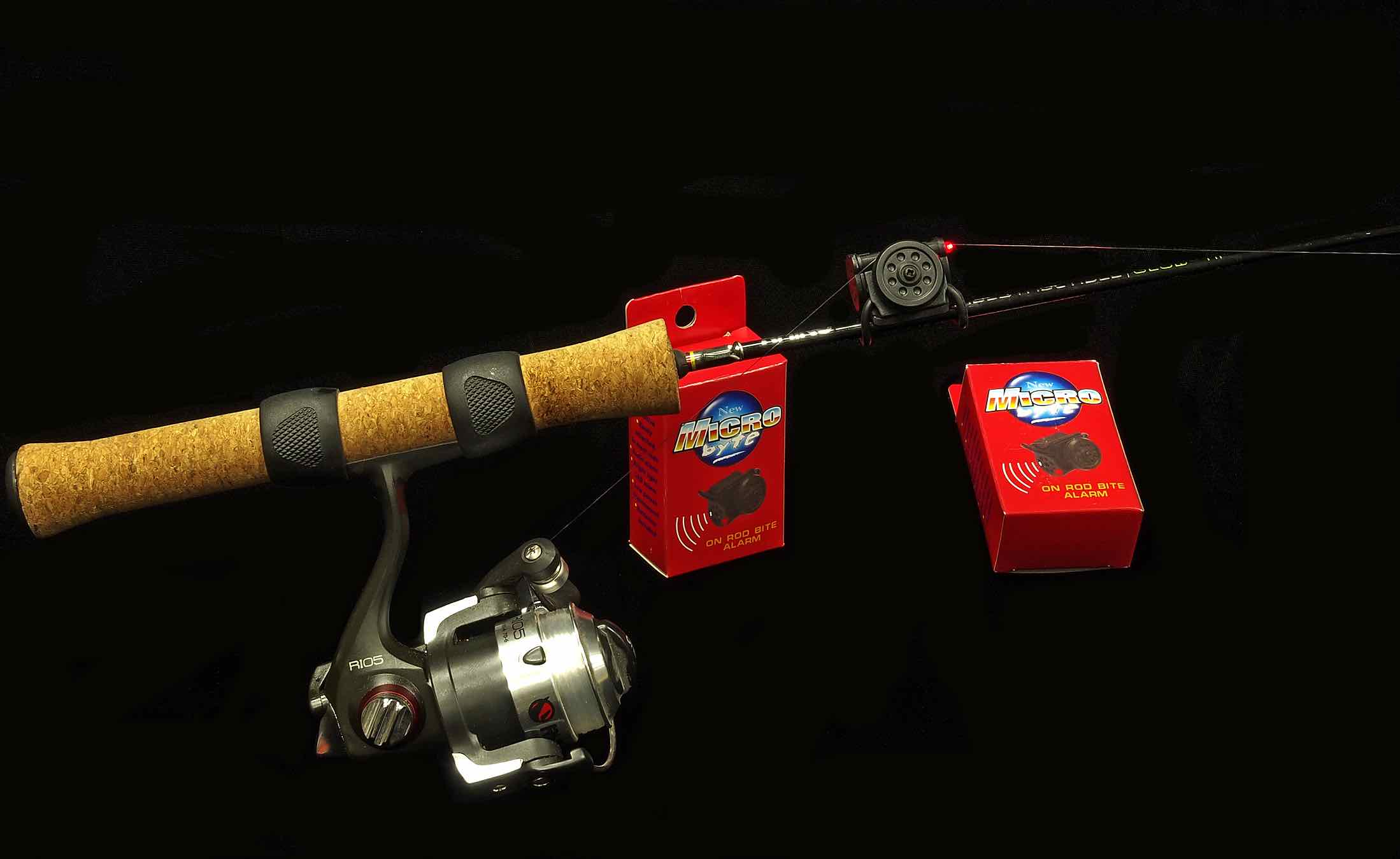 https://hooklineandsinker.ca/wp-content/uploads/2015/10/Micro-Electronic-Lighted-Bite-Alarm-AA.jpg
1349
2198
HLSAdmin
https://hooklineandsinker.ca/wp-content/uploads/2014/12/Steelheading-in-the-Snow-900-80-Not-Faded-Actual-1030x91.jpg
HLSAdmin2015-10-04 23:12:512017-04-10 20:20:59Electronic Bite Sound Alarm LED Fishing Light Alert
https://hooklineandsinker.ca/wp-content/uploads/2015/10/Micro-Electronic-Lighted-Bite-Alarm-AA.jpg
1349
2198
HLSAdmin
https://hooklineandsinker.ca/wp-content/uploads/2014/12/Steelheading-in-the-Snow-900-80-Not-Faded-Actual-1030x91.jpg
HLSAdmin2015-10-04 23:12:512017-04-10 20:20:59Electronic Bite Sound Alarm LED Fishing Light Alert https://hooklineandsinker.ca/wp-content/uploads/2019/07/shimano-slx-dc-casting-reel.jpg
300
540
HLSAdmin
https://hooklineandsinker.ca/wp-content/uploads/2014/12/Steelheading-in-the-Snow-900-80-Not-Faded-Actual-1030x91.jpg
HLSAdmin2019-07-10 22:22:502019-07-10 22:22:50Shimano SLX DC Baitcasting Reel
https://hooklineandsinker.ca/wp-content/uploads/2019/07/shimano-slx-dc-casting-reel.jpg
300
540
HLSAdmin
https://hooklineandsinker.ca/wp-content/uploads/2014/12/Steelheading-in-the-Snow-900-80-Not-Faded-Actual-1030x91.jpg
HLSAdmin2019-07-10 22:22:502019-07-10 22:22:50Shimano SLX DC Baitcasting Reel https://hooklineandsinker.ca/wp-content/uploads/2019/07/Shimano-Stradic-FL-Spinning-Reel.png
400
600
HLSAdmin
https://hooklineandsinker.ca/wp-content/uploads/2014/12/Steelheading-in-the-Snow-900-80-Not-Faded-Actual-1030x91.jpg
HLSAdmin2019-07-10 22:05:012019-07-10 22:05:01Shimano Stradic FL Spinning Reel
https://hooklineandsinker.ca/wp-content/uploads/2019/07/Shimano-Stradic-FL-Spinning-Reel.png
400
600
HLSAdmin
https://hooklineandsinker.ca/wp-content/uploads/2014/12/Steelheading-in-the-Snow-900-80-Not-Faded-Actual-1030x91.jpg
HLSAdmin2019-07-10 22:05:012019-07-10 22:05:01Shimano Stradic FL Spinning Reel https://hooklineandsinker.ca/wp-content/uploads/2019/08/Shimano-Stradic-2500HG-Spinning-Reel-F.jpg
1500
1500
HLSAdmin
https://hooklineandsinker.ca/wp-content/uploads/2014/12/Steelheading-in-the-Snow-900-80-Not-Faded-Actual-1030x91.jpg
HLSAdmin2019-08-04 21:43:242020-07-12 22:51:11Shimano Stradic 2500HGFK Spinning Reel
https://hooklineandsinker.ca/wp-content/uploads/2019/08/Shimano-Stradic-2500HG-Spinning-Reel-F.jpg
1500
1500
HLSAdmin
https://hooklineandsinker.ca/wp-content/uploads/2014/12/Steelheading-in-the-Snow-900-80-Not-Faded-Actual-1030x91.jpg
HLSAdmin2019-08-04 21:43:242020-07-12 22:51:11Shimano Stradic 2500HGFK Spinning Reel https://hooklineandsinker.ca/wp-content/uploads/2015/01/streamrunner3.jpg
333
500
HLSAdmin
https://hooklineandsinker.ca/wp-content/uploads/2014/12/Steelheading-in-the-Snow-900-80-Not-Faded-Actual-1030x91.jpg
HLSAdmin2015-01-08 19:04:342017-01-16 23:14:11Centerpin Float Reel Repairs
https://hooklineandsinker.ca/wp-content/uploads/2015/01/streamrunner3.jpg
333
500
HLSAdmin
https://hooklineandsinker.ca/wp-content/uploads/2014/12/Steelheading-in-the-Snow-900-80-Not-Faded-Actual-1030x91.jpg
HLSAdmin2015-01-08 19:04:342017-01-16 23:14:11Centerpin Float Reel Repairs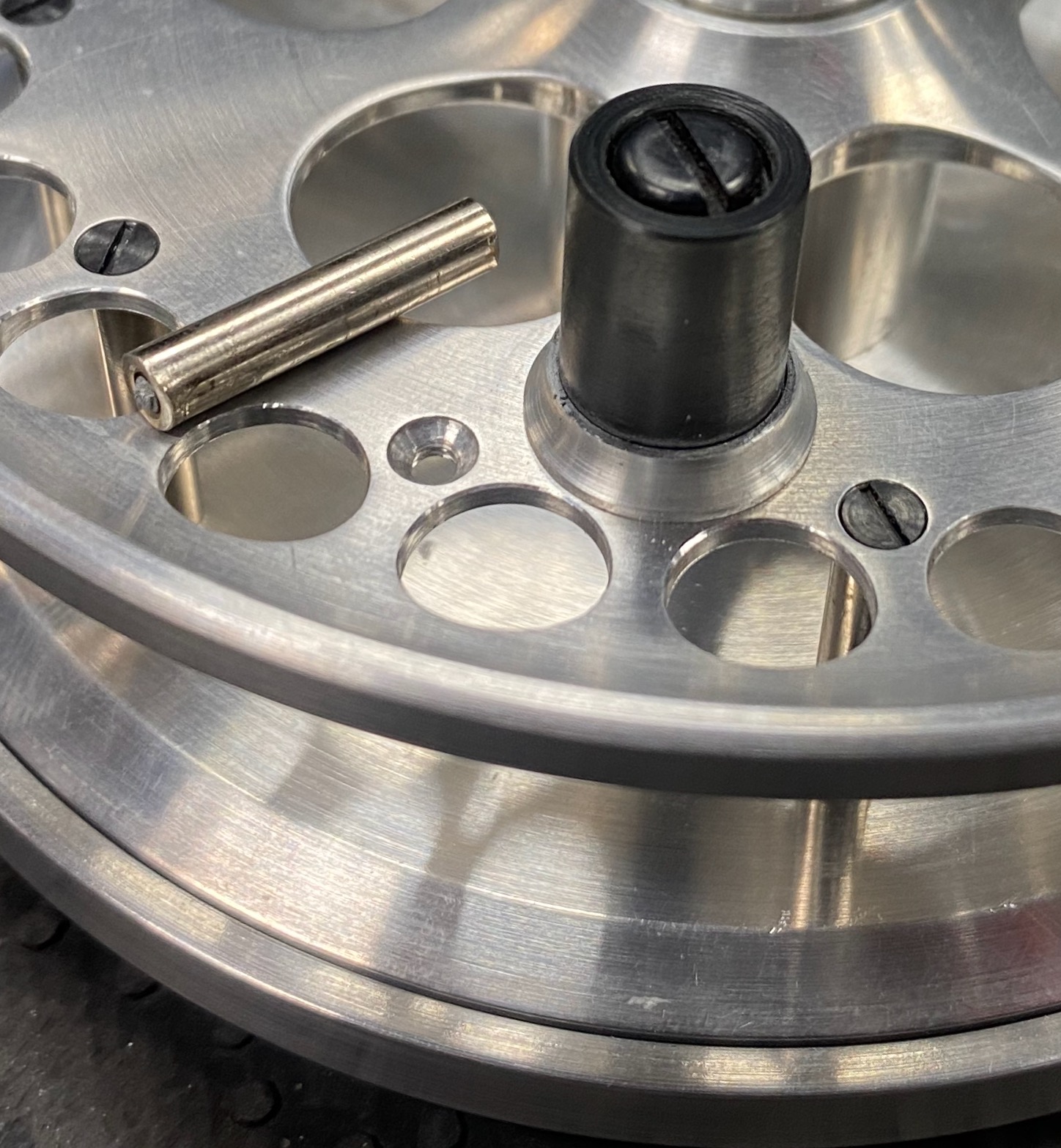 https://hooklineandsinker.ca/wp-content/uploads/2020/01/Stanton-Silver-Centerpin-Float-Reel-Broken-Spoke-AA.jpeg
1567
1448
HLSAdmin
https://hooklineandsinker.ca/wp-content/uploads/2014/12/Steelheading-in-the-Snow-900-80-Not-Faded-Actual-1030x91.jpg
HLSAdmin2020-01-12 18:11:322022-11-29 16:12:18Adcock Stanton Centerpin Float Reel Repairs
https://hooklineandsinker.ca/wp-content/uploads/2020/01/Stanton-Silver-Centerpin-Float-Reel-Broken-Spoke-AA.jpeg
1567
1448
HLSAdmin
https://hooklineandsinker.ca/wp-content/uploads/2014/12/Steelheading-in-the-Snow-900-80-Not-Faded-Actual-1030x91.jpg
HLSAdmin2020-01-12 18:11:322022-11-29 16:12:18Adcock Stanton Centerpin Float Reel Repairs https://hooklineandsinker.ca/wp-content/uploads/2020/07/Daiwa-BG-MQ-spinning-reels.png
603
585
HLSAdmin
https://hooklineandsinker.ca/wp-content/uploads/2014/12/Steelheading-in-the-Snow-900-80-Not-Faded-Actual-1030x91.jpg
HLSAdmin2020-07-13 21:47:232022-04-18 13:20:15Daiwa BG MQ Spinning Reels
https://hooklineandsinker.ca/wp-content/uploads/2020/07/Daiwa-BG-MQ-spinning-reels.png
603
585
HLSAdmin
https://hooklineandsinker.ca/wp-content/uploads/2014/12/Steelheading-in-the-Snow-900-80-Not-Faded-Actual-1030x91.jpg
HLSAdmin2020-07-13 21:47:232022-04-18 13:20:15Daiwa BG MQ Spinning Reels https://hooklineandsinker.ca/wp-content/uploads/2015/08/Abu-Garcia-Vintage-C3-and-C4-Aluminum-Spool-AA.jpg
1690
2450
HLSAdmin
https://hooklineandsinker.ca/wp-content/uploads/2014/12/Steelheading-in-the-Snow-900-80-Not-Faded-Actual-1030x91.jpg
HLSAdmin2018-10-01 22:01:272020-07-24 20:44:35Abu Garcia Custom Replacement Aluminum C3 & C4 Cardinal Spools
https://hooklineandsinker.ca/wp-content/uploads/2015/08/Abu-Garcia-Vintage-C3-and-C4-Aluminum-Spool-AA.jpg
1690
2450
HLSAdmin
https://hooklineandsinker.ca/wp-content/uploads/2014/12/Steelheading-in-the-Snow-900-80-Not-Faded-Actual-1030x91.jpg
HLSAdmin2018-10-01 22:01:272020-07-24 20:44:35Abu Garcia Custom Replacement Aluminum C3 & C4 Cardinal Spools https://hooklineandsinker.ca/wp-content/uploads/2018/09/SC_DaiwaReelOiler_cut02.jpg
225
225
HLSAdmin
https://hooklineandsinker.ca/wp-content/uploads/2014/12/Steelheading-in-the-Snow-900-80-Not-Faded-Actual-1030x91.jpg
HLSAdmin2018-09-22 21:29:272018-10-01 22:27:18Daiwa Space Age Needle Nose Reel Oiler
https://hooklineandsinker.ca/wp-content/uploads/2018/09/SC_DaiwaReelOiler_cut02.jpg
225
225
HLSAdmin
https://hooklineandsinker.ca/wp-content/uploads/2014/12/Steelheading-in-the-Snow-900-80-Not-Faded-Actual-1030x91.jpg
HLSAdmin2018-09-22 21:29:272018-10-01 22:27:18Daiwa Space Age Needle Nose Reel Oiler https://hooklineandsinker.ca/wp-content/uploads/2018/08/Shimano-Curado-DC-P-CURADO_DC.jpg
1500
1500
HLSAdmin
https://hooklineandsinker.ca/wp-content/uploads/2014/12/Steelheading-in-the-Snow-900-80-Not-Faded-Actual-1030x91.jpg
HLSAdmin2018-08-06 17:53:462020-03-17 21:37:54Shimano Curado DC Baitcast Reel
https://hooklineandsinker.ca/wp-content/uploads/2018/08/Shimano-Curado-DC-P-CURADO_DC.jpg
1500
1500
HLSAdmin
https://hooklineandsinker.ca/wp-content/uploads/2014/12/Steelheading-in-the-Snow-900-80-Not-Faded-Actual-1030x91.jpg
HLSAdmin2018-08-06 17:53:462020-03-17 21:37:54Shimano Curado DC Baitcast Reel https://hooklineandsinker.ca/wp-content/uploads/2015/06/HLS-Hi-Vis-Float-Line-Kingpin-Zeppelin-Float-Reel-Steelhead-AA.jpg
1017
1000
HLSAdmin
https://hooklineandsinker.ca/wp-content/uploads/2014/12/Steelheading-in-the-Snow-900-80-Not-Faded-Actual-1030x91.jpg
HLSAdmin2015-06-22 22:02:222018-04-15 14:38:56HLS Hi-Vis Steelhead Specific Fishing Line
https://hooklineandsinker.ca/wp-content/uploads/2015/06/HLS-Hi-Vis-Float-Line-Kingpin-Zeppelin-Float-Reel-Steelhead-AA.jpg
1017
1000
HLSAdmin
https://hooklineandsinker.ca/wp-content/uploads/2014/12/Steelheading-in-the-Snow-900-80-Not-Faded-Actual-1030x91.jpg
HLSAdmin2015-06-22 22:02:222018-04-15 14:38:56HLS Hi-Vis Steelhead Specific Fishing Line https://hooklineandsinker.ca/wp-content/uploads/2018/07/Shimano-Tranx-P-TRANX_300-400.jpg
1500
1500
HLSAdmin
https://hooklineandsinker.ca/wp-content/uploads/2014/12/Steelheading-in-the-Snow-900-80-Not-Faded-Actual-1030x91.jpg
HLSAdmin2018-07-26 23:36:562018-07-26 23:36:56Shimano Tranx
https://hooklineandsinker.ca/wp-content/uploads/2018/07/Shimano-Tranx-P-TRANX_300-400.jpg
1500
1500
HLSAdmin
https://hooklineandsinker.ca/wp-content/uploads/2014/12/Steelheading-in-the-Snow-900-80-Not-Faded-Actual-1030x91.jpg
HLSAdmin2018-07-26 23:36:562018-07-26 23:36:56Shimano Tranx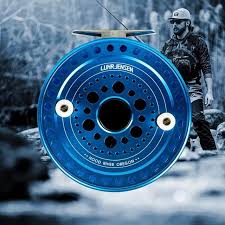 https://hooklineandsinker.ca/wp-content/uploads/2019/03/Luhr-Jensen-LJC-1-Limited-Edition-Legacy-Series-Centrepin-Float-Reel-A.jpg
225
225
HLSAdmin
https://hooklineandsinker.ca/wp-content/uploads/2014/12/Steelheading-in-the-Snow-900-80-Not-Faded-Actual-1030x91.jpg
HLSAdmin2019-03-17 17:51:442020-04-04 21:47:41Luhr Jensen LJC-1 Limited Edition Legacy Series Centrepin Float Reel
https://hooklineandsinker.ca/wp-content/uploads/2019/03/Luhr-Jensen-LJC-1-Limited-Edition-Legacy-Series-Centrepin-Float-Reel-A.jpg
225
225
HLSAdmin
https://hooklineandsinker.ca/wp-content/uploads/2014/12/Steelheading-in-the-Snow-900-80-Not-Faded-Actual-1030x91.jpg
HLSAdmin2019-03-17 17:51:442020-04-04 21:47:41Luhr Jensen LJC-1 Limited Edition Legacy Series Centrepin Float Reel https://hooklineandsinker.ca/wp-content/uploads/2019/03/2019-Rapala-R-Type-RTC450-Centerpin-Float-Reel-Series-Purple-A.png
486
486
HLSAdmin
https://hooklineandsinker.ca/wp-content/uploads/2014/12/Steelheading-in-the-Snow-900-80-Not-Faded-Actual-1030x91.jpg
HLSAdmin2019-03-17 16:49:062020-06-16 21:20:11Rapala R-Type RTC450 Centerpin Float Reel Series
https://hooklineandsinker.ca/wp-content/uploads/2019/03/2019-Rapala-R-Type-RTC450-Centerpin-Float-Reel-Series-Purple-A.png
486
486
HLSAdmin
https://hooklineandsinker.ca/wp-content/uploads/2014/12/Steelheading-in-the-Snow-900-80-Not-Faded-Actual-1030x91.jpg
HLSAdmin2019-03-17 16:49:062020-06-16 21:20:11Rapala R-Type RTC450 Centerpin Float Reel Series https://hooklineandsinker.ca/wp-content/uploads/2017/06/Ross-Balance-Adjustable-Arm-AA.jpg
1315
2450
HLSAdmin
https://hooklineandsinker.ca/wp-content/uploads/2014/12/Steelheading-in-the-Snow-900-80-Not-Faded-Actual-1030x91.jpg
HLSAdmin2017-06-18 17:24:392017-06-18 17:24:39Ross Balance Adjustable Arm
https://hooklineandsinker.ca/wp-content/uploads/2017/06/Ross-Balance-Adjustable-Arm-AA.jpg
1315
2450
HLSAdmin
https://hooklineandsinker.ca/wp-content/uploads/2014/12/Steelheading-in-the-Snow-900-80-Not-Faded-Actual-1030x91.jpg
HLSAdmin2017-06-18 17:24:392017-06-18 17:24:39Ross Balance Adjustable Arm https://hooklineandsinker.ca/wp-content/uploads/2016/02/Blakemore-Reel-Magic-Product-Image.jpg
500
500
HLSAdmin
https://hooklineandsinker.ca/wp-content/uploads/2014/12/Steelheading-in-the-Snow-900-80-Not-Faded-Actual-1030x91.jpg
HLSAdmin2016-02-08 21:09:322017-02-19 21:32:11Blakemore® Real Magic® Lubricants
https://hooklineandsinker.ca/wp-content/uploads/2016/02/Blakemore-Reel-Magic-Product-Image.jpg
500
500
HLSAdmin
https://hooklineandsinker.ca/wp-content/uploads/2014/12/Steelheading-in-the-Snow-900-80-Not-Faded-Actual-1030x91.jpg
HLSAdmin2016-02-08 21:09:322017-02-19 21:32:11Blakemore® Real Magic® Lubricants https://hooklineandsinker.ca/wp-content/uploads/2014/03/Assorted-Centerpin-Float-Reel-and-Fly-Reel-Backing-Colours-AA.jpg
1438
2198
HLSAdmin
https://hooklineandsinker.ca/wp-content/uploads/2014/12/Steelheading-in-the-Snow-900-80-Not-Faded-Actual-1030x91.jpg
HLSAdmin2016-04-21 20:06:082018-10-15 21:05:48Fly / Float / Centerpin Reel Backing – Exclusive Custom Colours
https://hooklineandsinker.ca/wp-content/uploads/2014/03/Assorted-Centerpin-Float-Reel-and-Fly-Reel-Backing-Colours-AA.jpg
1438
2198
HLSAdmin
https://hooklineandsinker.ca/wp-content/uploads/2014/12/Steelheading-in-the-Snow-900-80-Not-Faded-Actual-1030x91.jpg
HLSAdmin2016-04-21 20:06:082018-10-15 21:05:48Fly / Float / Centerpin Reel Backing – Exclusive Custom Colours https://hooklineandsinker.ca/wp-content/uploads/2014/10/Shimano-Fishing-Logo.jpg
225
225
Ray Collesso
https://hooklineandsinker.ca/wp-content/uploads/2014/12/Steelheading-in-the-Snow-900-80-Not-Faded-Actual-1030x91.jpg
Ray Collesso2014-10-14 14:10:022021-10-10 20:33:14Shimano Fishing Rods, Reels & Accessories
https://hooklineandsinker.ca/wp-content/uploads/2014/10/Shimano-Fishing-Logo.jpg
225
225
Ray Collesso
https://hooklineandsinker.ca/wp-content/uploads/2014/12/Steelheading-in-the-Snow-900-80-Not-Faded-Actual-1030x91.jpg
Ray Collesso2014-10-14 14:10:022021-10-10 20:33:14Shimano Fishing Rods, Reels & Accessories https://hooklineandsinker.ca/wp-content/uploads/2016/02/Quantum-Hot-Sauce-and-Grease-Product-Image.jpg
200
200
HLSAdmin
https://hooklineandsinker.ca/wp-content/uploads/2014/12/Steelheading-in-the-Snow-900-80-Not-Faded-Actual-1030x91.jpg
HLSAdmin2016-02-08 22:03:042017-02-19 15:04:50Quantum®’s Special Low-Viscosity Hot Sauce™ Reel Oil & Reel Grease
https://hooklineandsinker.ca/wp-content/uploads/2016/02/Quantum-Hot-Sauce-and-Grease-Product-Image.jpg
200
200
HLSAdmin
https://hooklineandsinker.ca/wp-content/uploads/2014/12/Steelheading-in-the-Snow-900-80-Not-Faded-Actual-1030x91.jpg
HLSAdmin2016-02-08 22:03:042017-02-19 15:04:50Quantum®’s Special Low-Viscosity Hot Sauce™ Reel Oil & Reel Grease https://hooklineandsinker.ca/wp-content/uploads/2015/07/Kingpin-Zeppelin-Centerpin-Float-Reel-E-Resized.jpg
2951
2448
HLSAdmin
https://hooklineandsinker.ca/wp-content/uploads/2014/12/Steelheading-in-the-Snow-900-80-Not-Faded-Actual-1030x91.jpg
HLSAdmin2015-07-03 14:53:332017-07-26 20:03:13Custom Kingpin Zeppelin & R2 Float Reel Selection
https://hooklineandsinker.ca/wp-content/uploads/2015/07/Kingpin-Zeppelin-Centerpin-Float-Reel-E-Resized.jpg
2951
2448
HLSAdmin
https://hooklineandsinker.ca/wp-content/uploads/2014/12/Steelheading-in-the-Snow-900-80-Not-Faded-Actual-1030x91.jpg
HLSAdmin2015-07-03 14:53:332017-07-26 20:03:13Custom Kingpin Zeppelin & R2 Float Reel Selection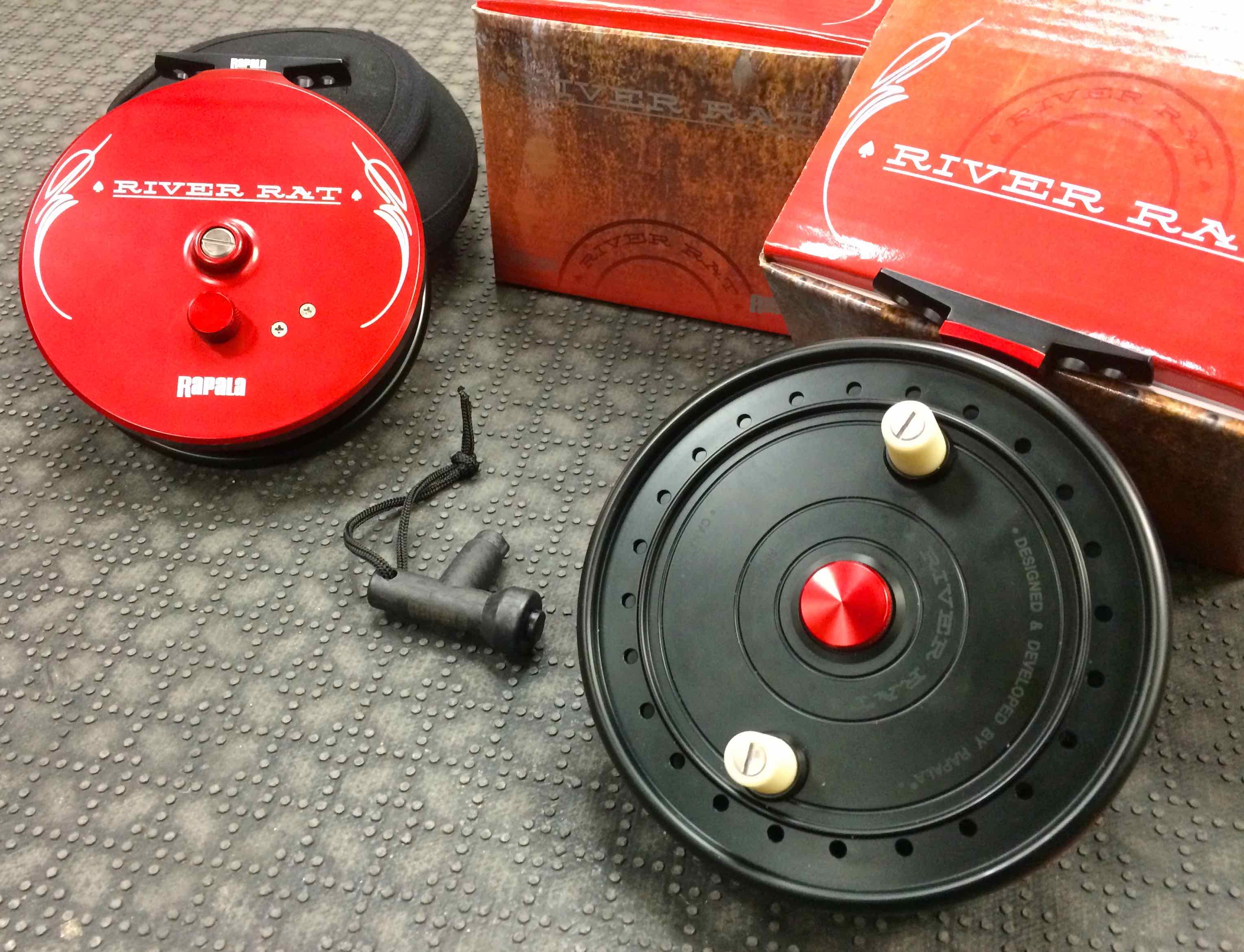 https://hooklineandsinker.ca/wp-content/uploads/2016/01/New-2016-Rapala-River-Rat-Centerpin-Float-Reel-RRC465-BB.jpg
2339
3057
HLSAdmin
https://hooklineandsinker.ca/wp-content/uploads/2014/12/Steelheading-in-the-Snow-900-80-Not-Faded-Actual-1030x91.jpg
HLSAdmin2016-01-22 22:29:132020-04-04 21:52:12Rapala River Rat Centerpin Float Reel – RRC465
https://hooklineandsinker.ca/wp-content/uploads/2016/01/New-2016-Rapala-River-Rat-Centerpin-Float-Reel-RRC465-BB.jpg
2339
3057
HLSAdmin
https://hooklineandsinker.ca/wp-content/uploads/2014/12/Steelheading-in-the-Snow-900-80-Not-Faded-Actual-1030x91.jpg
HLSAdmin2016-01-22 22:29:132020-04-04 21:52:12Rapala River Rat Centerpin Float Reel – RRC465 https://hooklineandsinker.ca/wp-content/uploads/2015/07/Assorted-Spinng-Reel-Baitcast-Reel-Pouches-AA.jpg
1082
1844
HLSAdmin
https://hooklineandsinker.ca/wp-content/uploads/2014/12/Steelheading-in-the-Snow-900-80-Not-Faded-Actual-1030x91.jpg
HLSAdmin2015-07-19 17:53:272017-02-26 18:10:37Protective Fishing Reel Pouches
https://hooklineandsinker.ca/wp-content/uploads/2015/07/Assorted-Spinng-Reel-Baitcast-Reel-Pouches-AA.jpg
1082
1844
HLSAdmin
https://hooklineandsinker.ca/wp-content/uploads/2014/12/Steelheading-in-the-Snow-900-80-Not-Faded-Actual-1030x91.jpg
HLSAdmin2015-07-19 17:53:272017-02-26 18:10:37Protective Fishing Reel Pouches https://hooklineandsinker.ca/wp-content/uploads/2014/10/Daiwa-LogoB.jpg
170
296
Ray Collesso
https://hooklineandsinker.ca/wp-content/uploads/2014/12/Steelheading-in-the-Snow-900-80-Not-Faded-Actual-1030x91.jpg
Ray Collesso2014-10-14 19:08:012019-06-08 22:49:40Daiwa Fishing Rods, Reels, Lures & Lines
https://hooklineandsinker.ca/wp-content/uploads/2014/10/Daiwa-LogoB.jpg
170
296
Ray Collesso
https://hooklineandsinker.ca/wp-content/uploads/2014/12/Steelheading-in-the-Snow-900-80-Not-Faded-Actual-1030x91.jpg
Ray Collesso2014-10-14 19:08:012019-06-08 22:49:40Daiwa Fishing Rods, Reels, Lures & Lines https://hooklineandsinker.ca/wp-content/uploads/2018/09/Amundson-Outdoors-Canada-home_2.jpg
55
280
HLSAdmin
https://hooklineandsinker.ca/wp-content/uploads/2014/12/Steelheading-in-the-Snow-900-80-Not-Faded-Actual-1030x91.jpg
HLSAdmin2018-09-03 16:09:582018-09-03 16:09:58Amundson Outdoors Canada
https://hooklineandsinker.ca/wp-content/uploads/2018/09/Amundson-Outdoors-Canada-home_2.jpg
55
280
HLSAdmin
https://hooklineandsinker.ca/wp-content/uploads/2014/12/Steelheading-in-the-Snow-900-80-Not-Faded-Actual-1030x91.jpg
HLSAdmin2018-09-03 16:09:582018-09-03 16:09:58Amundson Outdoors Canada https://hooklineandsinker.ca/wp-content/uploads/2014/10/Rapala-Fishing-Logo.jpg
225
225
Ray Collesso
https://hooklineandsinker.ca/wp-content/uploads/2014/12/Steelheading-in-the-Snow-900-80-Not-Faded-Actual-1030x91.jpg
Ray Collesso2014-10-14 19:30:282017-01-26 20:27:00Rapala Fishing Rods, Reels, Lines & Lures
https://hooklineandsinker.ca/wp-content/uploads/2014/10/Rapala-Fishing-Logo.jpg
225
225
Ray Collesso
https://hooklineandsinker.ca/wp-content/uploads/2014/12/Steelheading-in-the-Snow-900-80-Not-Faded-Actual-1030x91.jpg
Ray Collesso2014-10-14 19:30:282017-01-26 20:27:00Rapala Fishing Rods, Reels, Lines & Lures https://hooklineandsinker.ca/wp-content/uploads/2014/10/Okuma-Logo.jpg
186
271
Ray Collesso
https://hooklineandsinker.ca/wp-content/uploads/2014/12/Steelheading-in-the-Snow-900-80-Not-Faded-Actual-1030x91.jpg
Ray Collesso2014-10-14 14:58:462016-08-10 23:26:51Okuma Fishing Rods & Reels
https://hooklineandsinker.ca/wp-content/uploads/2014/10/Okuma-Logo.jpg
186
271
Ray Collesso
https://hooklineandsinker.ca/wp-content/uploads/2014/12/Steelheading-in-the-Snow-900-80-Not-Faded-Actual-1030x91.jpg
Ray Collesso2014-10-14 14:58:462016-08-10 23:26:51Okuma Fishing Rods & Reels https://hooklineandsinker.ca/wp-content/uploads/2019/04/Luhr-Jensen-Legacy-Limited-Edition-Mooching-Reel-D.jpg
225
225
HLSAdmin
https://hooklineandsinker.ca/wp-content/uploads/2014/12/Steelheading-in-the-Snow-900-80-Not-Faded-Actual-1030x91.jpg
HLSAdmin2019-04-27 22:26:522019-05-06 20:45:43Luhr-Jensen Legacy Series Mooching Rod & Reel
https://hooklineandsinker.ca/wp-content/uploads/2019/04/Luhr-Jensen-Legacy-Limited-Edition-Mooching-Reel-D.jpg
225
225
HLSAdmin
https://hooklineandsinker.ca/wp-content/uploads/2014/12/Steelheading-in-the-Snow-900-80-Not-Faded-Actual-1030x91.jpg
HLSAdmin2019-04-27 22:26:522019-05-06 20:45:43Luhr-Jensen Legacy Series Mooching Rod & Reel https://hooklineandsinker.ca/wp-content/uploads/2014/10/lews-logo-2x.png
246
420
Ray Collesso
https://hooklineandsinker.ca/wp-content/uploads/2014/12/Steelheading-in-the-Snow-900-80-Not-Faded-Actual-1030x91.jpg
Ray Collesso2014-10-23 11:43:032014-11-30 20:11:18Lew’s Fishing Rods & Reels
https://hooklineandsinker.ca/wp-content/uploads/2014/10/lews-logo-2x.png
246
420
Ray Collesso
https://hooklineandsinker.ca/wp-content/uploads/2014/12/Steelheading-in-the-Snow-900-80-Not-Faded-Actual-1030x91.jpg
Ray Collesso2014-10-23 11:43:032014-11-30 20:11:18Lew’s Fishing Rods & Reels https://hooklineandsinker.ca/wp-content/uploads/2014/10/Quantum-Fishing-Tackle-Logo.jpg
192
192
Ray Collesso
https://hooklineandsinker.ca/wp-content/uploads/2014/12/Steelheading-in-the-Snow-900-80-Not-Faded-Actual-1030x91.jpg
Ray Collesso2014-10-14 14:28:342014-10-14 19:13:09Quantum Fishing Rods & Reels
https://hooklineandsinker.ca/wp-content/uploads/2014/10/Quantum-Fishing-Tackle-Logo.jpg
192
192
Ray Collesso
https://hooklineandsinker.ca/wp-content/uploads/2014/12/Steelheading-in-the-Snow-900-80-Not-Faded-Actual-1030x91.jpg
Ray Collesso2014-10-14 14:28:342014-10-14 19:13:09Quantum Fishing Rods & Reels https://hooklineandsinker.ca/wp-content/uploads/2014/11/US-Reel-Company-Logo-B.jpg
225
225
Ray Collesso
https://hooklineandsinker.ca/wp-content/uploads/2014/12/Steelheading-in-the-Snow-900-80-Not-Faded-Actual-1030x91.jpg
Ray Collesso2014-11-24 16:58:202014-11-24 18:31:53U.S. Reel Company Fishing Reels
https://hooklineandsinker.ca/wp-content/uploads/2014/11/US-Reel-Company-Logo-B.jpg
225
225
Ray Collesso
https://hooklineandsinker.ca/wp-content/uploads/2014/12/Steelheading-in-the-Snow-900-80-Not-Faded-Actual-1030x91.jpg
Ray Collesso2014-11-24 16:58:202014-11-24 18:31:53U.S. Reel Company Fishing Reels https://hooklineandsinker.ca/wp-content/uploads/2015/02/Berkley-Fishing-Logo.jpg
191
240
HLSAdmin
https://hooklineandsinker.ca/wp-content/uploads/2014/12/Steelheading-in-the-Snow-900-80-Not-Faded-Actual-1030x91.jpg
HLSAdmin2015-02-12 16:52:452017-02-12 19:42:25Berkley Fishing – Rods, Reels, Lures, Soft Plastics, Monofilaments, Fluorocarbons, Tapered Leaders and Tippets
https://hooklineandsinker.ca/wp-content/uploads/2015/02/Berkley-Fishing-Logo.jpg
191
240
HLSAdmin
https://hooklineandsinker.ca/wp-content/uploads/2014/12/Steelheading-in-the-Snow-900-80-Not-Faded-Actual-1030x91.jpg
HLSAdmin2015-02-12 16:52:452017-02-12 19:42:25Berkley Fishing – Rods, Reels, Lures, Soft Plastics, Monofilaments, Fluorocarbons, Tapered Leaders and Tippets https://hooklineandsinker.ca/wp-content/uploads/2014/11/Zebco-Fishing-Logo.jpg
194
259
Ray Collesso
https://hooklineandsinker.ca/wp-content/uploads/2014/12/Steelheading-in-the-Snow-900-80-Not-Faded-Actual-1030x91.jpg
Ray Collesso2014-11-24 16:22:332014-11-24 18:56:30Zebco Fishing
https://hooklineandsinker.ca/wp-content/uploads/2014/11/Zebco-Fishing-Logo.jpg
194
259
Ray Collesso
https://hooklineandsinker.ca/wp-content/uploads/2014/12/Steelheading-in-the-Snow-900-80-Not-Faded-Actual-1030x91.jpg
Ray Collesso2014-11-24 16:22:332014-11-24 18:56:30Zebco Fishing https://hooklineandsinker.ca/wp-content/uploads/2016/04/Johnson-Fishing-Logo-Image.jpg
225
225
HLSAdmin
https://hooklineandsinker.ca/wp-content/uploads/2014/12/Steelheading-in-the-Snow-900-80-Not-Faded-Actual-1030x91.jpg
HLSAdmin2016-04-18 19:50:332016-04-21 18:58:12Johnson Hard & Soft Baits
https://hooklineandsinker.ca/wp-content/uploads/2016/04/Johnson-Fishing-Logo-Image.jpg
225
225
HLSAdmin
https://hooklineandsinker.ca/wp-content/uploads/2014/12/Steelheading-in-the-Snow-900-80-Not-Faded-Actual-1030x91.jpg
HLSAdmin2016-04-18 19:50:332016-04-21 18:58:12Johnson Hard & Soft Baits https://hooklineandsinker.ca/wp-content/uploads/2014/11/Rhino-Fishing-Logo.jpg
225
225
Ray Collesso
https://hooklineandsinker.ca/wp-content/uploads/2014/12/Steelheading-in-the-Snow-900-80-Not-Faded-Actual-1030x91.jpg
Ray Collesso2014-11-24 18:55:282014-11-24 19:48:17Rhino Fishing Rods & Reels
https://hooklineandsinker.ca/wp-content/uploads/2014/11/Rhino-Fishing-Logo.jpg
225
225
Ray Collesso
https://hooklineandsinker.ca/wp-content/uploads/2014/12/Steelheading-in-the-Snow-900-80-Not-Faded-Actual-1030x91.jpg
Ray Collesso2014-11-24 18:55:282014-11-24 19:48:17Rhino Fishing Rods & ReelsServices
 https://hooklineandsinker.ca/wp-content/uploads/2023/03/IMG_0479-scaled.jpg
1749
2560
HLSAdmin
https://hooklineandsinker.ca/wp-content/uploads/2014/12/Steelheading-in-the-Snow-900-80-Not-Faded-Actual-1030x91.jpg
HLSAdmin2023-03-20 12:58:332023-03-20 16:51:51Retirement Announcement
https://hooklineandsinker.ca/wp-content/uploads/2023/03/IMG_0479-scaled.jpg
1749
2560
HLSAdmin
https://hooklineandsinker.ca/wp-content/uploads/2014/12/Steelheading-in-the-Snow-900-80-Not-Faded-Actual-1030x91.jpg
HLSAdmin2023-03-20 12:58:332023-03-20 16:51:51Retirement Announcement https://hooklineandsinker.ca/wp-content/uploads/2015/07/HLS-Custom-UV-Beads-and-HLS-Bead-Pegs-AA.jpg
1706
2448
Ray Collesso
https://hooklineandsinker.ca/wp-content/uploads/2014/12/Steelheading-in-the-Snow-900-80-Not-Faded-Actual-1030x91.jpg
Ray Collesso2014-11-24 16:01:142018-06-03 13:06:57HLS Custom UV Ultra Violet Steelhead Beads
https://hooklineandsinker.ca/wp-content/uploads/2015/07/HLS-Custom-UV-Beads-and-HLS-Bead-Pegs-AA.jpg
1706
2448
Ray Collesso
https://hooklineandsinker.ca/wp-content/uploads/2014/12/Steelheading-in-the-Snow-900-80-Not-Faded-Actual-1030x91.jpg
Ray Collesso2014-11-24 16:01:142018-06-03 13:06:57HLS Custom UV Ultra Violet Steelhead Beads https://hooklineandsinker.ca/wp-content/uploads/2014/10/Custom-HLS-Acrylic-Reel-Seat-Butt-Cap-and-Islander-Handle-Conversion-Replacement-A.jpg
270
360
Ray Collesso
https://hooklineandsinker.ca/wp-content/uploads/2014/12/Steelheading-in-the-Snow-900-80-Not-Faded-Actual-1030x91.jpg
Ray Collesso2014-10-15 22:24:142017-02-12 18:43:27Custom Reel Seats for Rod Building
https://hooklineandsinker.ca/wp-content/uploads/2014/10/Custom-HLS-Acrylic-Reel-Seat-Butt-Cap-and-Islander-Handle-Conversion-Replacement-A.jpg
270
360
Ray Collesso
https://hooklineandsinker.ca/wp-content/uploads/2014/12/Steelheading-in-the-Snow-900-80-Not-Faded-Actual-1030x91.jpg
Ray Collesso2014-10-15 22:24:142017-02-12 18:43:27Custom Reel Seats for Rod Building https://hooklineandsinker.ca/wp-content/uploads/2014/01/Custom-IMX-ST1562-cw-Jungle-Cock-Inlays-Resized-for-Web.jpg
2448
2448
Ray Collesso
https://hooklineandsinker.ca/wp-content/uploads/2014/12/Steelheading-in-the-Snow-900-80-Not-Faded-Actual-1030x91.jpg
Ray Collesso2014-01-08 11:51:302017-01-16 22:57:27Custom Rod Building, Rod Building Components and Custom Rod Parts
https://hooklineandsinker.ca/wp-content/uploads/2014/01/Custom-IMX-ST1562-cw-Jungle-Cock-Inlays-Resized-for-Web.jpg
2448
2448
Ray Collesso
https://hooklineandsinker.ca/wp-content/uploads/2014/12/Steelheading-in-the-Snow-900-80-Not-Faded-Actual-1030x91.jpg
Ray Collesso2014-01-08 11:51:302017-01-16 22:57:27Custom Rod Building, Rod Building Components and Custom Rod Parts https://hooklineandsinker.ca/wp-content/uploads/2016/08/GLX-Strip-and-Rebuild-Cork-Handle-with-Custom-Reel-Seat-and-Hook-Keeper-CCC.jpg
1871
4026
HLSAdmin
https://hooklineandsinker.ca/wp-content/uploads/2014/12/Steelheading-in-the-Snow-900-80-Not-Faded-Actual-1030x91.jpg
HLSAdmin2016-08-17 22:43:022018-08-06 14:52:52G. Loomis GLX & IMX Centerpin Float Rod Handle Conversion
https://hooklineandsinker.ca/wp-content/uploads/2016/08/GLX-Strip-and-Rebuild-Cork-Handle-with-Custom-Reel-Seat-and-Hook-Keeper-CCC.jpg
1871
4026
HLSAdmin
https://hooklineandsinker.ca/wp-content/uploads/2014/12/Steelheading-in-the-Snow-900-80-Not-Faded-Actual-1030x91.jpg
HLSAdmin2016-08-17 22:43:022018-08-06 14:52:52G. Loomis GLX & IMX Centerpin Float Rod Handle Conversion https://hooklineandsinker.ca/wp-content/uploads/2017/03/Sage-Method-6119-4X22-BBBB.jpg
530
360
HLSAdmin
https://hooklineandsinker.ca/wp-content/uploads/2014/12/Steelheading-in-the-Snow-900-80-Not-Faded-Actual-1030x91.jpg
HLSAdmin2017-03-05 00:01:112019-08-25 19:45:22Custom Acid Rod or Spiral Wrap Guides on Longer Baitcast Rods for Steelheading
https://hooklineandsinker.ca/wp-content/uploads/2017/03/Sage-Method-6119-4X22-BBBB.jpg
530
360
HLSAdmin
https://hooklineandsinker.ca/wp-content/uploads/2014/12/Steelheading-in-the-Snow-900-80-Not-Faded-Actual-1030x91.jpg
HLSAdmin2017-03-05 00:01:112019-08-25 19:45:22Custom Acid Rod or Spiral Wrap Guides on Longer Baitcast Rods for Steelheading https://hooklineandsinker.ca/wp-content/uploads/2014/10/Float-Centerpin-Reel-Bearings-B-Resized.jpg
1925
2448
Ray Collesso
https://hooklineandsinker.ca/wp-content/uploads/2014/12/Steelheading-in-the-Snow-900-80-Not-Faded-Actual-1030x91.jpg
Ray Collesso2014-10-21 22:58:282019-05-06 20:35:45Centerpin Float Reel & Fly Reel Bearing Replacement
https://hooklineandsinker.ca/wp-content/uploads/2014/10/Float-Centerpin-Reel-Bearings-B-Resized.jpg
1925
2448
Ray Collesso
https://hooklineandsinker.ca/wp-content/uploads/2014/12/Steelheading-in-the-Snow-900-80-Not-Faded-Actual-1030x91.jpg
Ray Collesso2014-10-21 22:58:282019-05-06 20:35:45Centerpin Float Reel & Fly Reel Bearing Replacement https://hooklineandsinker.ca/wp-content/uploads/2015/01/streamrunner3.jpg
333
500
HLSAdmin
https://hooklineandsinker.ca/wp-content/uploads/2014/12/Steelheading-in-the-Snow-900-80-Not-Faded-Actual-1030x91.jpg
HLSAdmin2015-01-08 19:04:342017-01-16 23:14:11Centerpin Float Reel Repairs
https://hooklineandsinker.ca/wp-content/uploads/2015/01/streamrunner3.jpg
333
500
HLSAdmin
https://hooklineandsinker.ca/wp-content/uploads/2014/12/Steelheading-in-the-Snow-900-80-Not-Faded-Actual-1030x91.jpg
HLSAdmin2015-01-08 19:04:342017-01-16 23:14:11Centerpin Float Reel Repairs https://hooklineandsinker.ca/wp-content/uploads/2020/01/Stanton-Silver-Centerpin-Float-Reel-Broken-Spoke-AA.jpeg
1567
1448
HLSAdmin
https://hooklineandsinker.ca/wp-content/uploads/2014/12/Steelheading-in-the-Snow-900-80-Not-Faded-Actual-1030x91.jpg
HLSAdmin2020-01-12 18:11:322022-11-29 16:12:18Adcock Stanton Centerpin Float Reel Repairs
https://hooklineandsinker.ca/wp-content/uploads/2020/01/Stanton-Silver-Centerpin-Float-Reel-Broken-Spoke-AA.jpeg
1567
1448
HLSAdmin
https://hooklineandsinker.ca/wp-content/uploads/2014/12/Steelheading-in-the-Snow-900-80-Not-Faded-Actual-1030x91.jpg
HLSAdmin2020-01-12 18:11:322022-11-29 16:12:18Adcock Stanton Centerpin Float Reel Repairs https://hooklineandsinker.ca/wp-content/uploads/2015/03/Custom-Rod-Building-HLS-Mike-Rumig-02132016-AA.jpg
1458
1387
HLSAdmin
https://hooklineandsinker.ca/wp-content/uploads/2014/12/Steelheading-in-the-Snow-900-80-Not-Faded-Actual-1030x91.jpg
HLSAdmin2016-06-13 21:10:462018-11-14 23:20:56HLS Fishing Rod Building Classes
https://hooklineandsinker.ca/wp-content/uploads/2015/03/Custom-Rod-Building-HLS-Mike-Rumig-02132016-AA.jpg
1458
1387
HLSAdmin
https://hooklineandsinker.ca/wp-content/uploads/2014/12/Steelheading-in-the-Snow-900-80-Not-Faded-Actual-1030x91.jpg
HLSAdmin2016-06-13 21:10:462018-11-14 23:20:56HLS Fishing Rod Building Classes https://hooklineandsinker.ca/wp-content/uploads/2015/01/Custom-HLS-Float-Reel-Rosewood-Handles-Slainless-Palming-Ring-Red-Front-Resized-for-Web.jpg
2084
2147
HLSAdmin
https://hooklineandsinker.ca/wp-content/uploads/2014/12/Steelheading-in-the-Snow-900-80-Not-Faded-Actual-1030x91.jpg
HLSAdmin2015-01-08 18:21:292017-01-09 00:15:37Custom Made Centerpin Float Reels – One of a kind!
https://hooklineandsinker.ca/wp-content/uploads/2015/01/Custom-HLS-Float-Reel-Rosewood-Handles-Slainless-Palming-Ring-Red-Front-Resized-for-Web.jpg
2084
2147
HLSAdmin
https://hooklineandsinker.ca/wp-content/uploads/2014/12/Steelheading-in-the-Snow-900-80-Not-Faded-Actual-1030x91.jpg
HLSAdmin2015-01-08 18:21:292017-01-09 00:15:37Custom Made Centerpin Float Reels – One of a kind! https://hooklineandsinker.ca/wp-content/uploads/2014/02/Used-But-Not-Abused-Page-Image.jpg
160
160
Ray Collesso
https://hooklineandsinker.ca/wp-content/uploads/2014/12/Steelheading-in-the-Snow-900-80-Not-Faded-Actual-1030x91.jpg
Ray Collesso2014-02-19 17:26:492017-01-17 12:15:05Used But NOT Abused (UBNA)
https://hooklineandsinker.ca/wp-content/uploads/2014/02/Used-But-Not-Abused-Page-Image.jpg
160
160
Ray Collesso
https://hooklineandsinker.ca/wp-content/uploads/2014/12/Steelheading-in-the-Snow-900-80-Not-Faded-Actual-1030x91.jpg
Ray Collesso2014-02-19 17:26:492017-01-17 12:15:05Used But NOT Abused (UBNA) https://hooklineandsinker.ca/wp-content/uploads/2014/02/Weekly-Guest-Presenter-Button.jpg
224
225
Ray Collesso
https://hooklineandsinker.ca/wp-content/uploads/2014/12/Steelheading-in-the-Snow-900-80-Not-Faded-Actual-1030x91.jpg
Ray Collesso2014-02-17 19:43:022017-01-16 23:35:04Weekly Guest Tyer / Presenter Events – Sat. Noon to 3.
https://hooklineandsinker.ca/wp-content/uploads/2014/02/Weekly-Guest-Presenter-Button.jpg
224
225
Ray Collesso
https://hooklineandsinker.ca/wp-content/uploads/2014/12/Steelheading-in-the-Snow-900-80-Not-Faded-Actual-1030x91.jpg
Ray Collesso2014-02-17 19:43:022017-01-16 23:35:04Weekly Guest Tyer / Presenter Events – Sat. Noon to 3. https://hooklineandsinker.ca/wp-content/uploads/2014/03/Clearance-Page-Image.jpg
211
239
Ray Collesso
https://hooklineandsinker.ca/wp-content/uploads/2014/12/Steelheading-in-the-Snow-900-80-Not-Faded-Actual-1030x91.jpg
Ray Collesso2014-03-02 22:21:232017-02-12 14:38:52Clearance and Sale Items
https://hooklineandsinker.ca/wp-content/uploads/2014/03/Clearance-Page-Image.jpg
211
239
Ray Collesso
https://hooklineandsinker.ca/wp-content/uploads/2014/12/Steelheading-in-the-Snow-900-80-Not-Faded-Actual-1030x91.jpg
Ray Collesso2014-03-02 22:21:232017-02-12 14:38:52Clearance and Sale Items https://hooklineandsinker.ca/wp-content/uploads/2014/02/Warranty-Button.jpg
225
225
Ray Collesso
https://hooklineandsinker.ca/wp-content/uploads/2014/12/Steelheading-in-the-Snow-900-80-Not-Faded-Actual-1030x91.jpg
Ray Collesso2014-02-11 22:02:342017-01-16 22:37:06Warranty Repairs & Service
https://hooklineandsinker.ca/wp-content/uploads/2014/02/Warranty-Button.jpg
225
225
Ray Collesso
https://hooklineandsinker.ca/wp-content/uploads/2014/12/Steelheading-in-the-Snow-900-80-Not-Faded-Actual-1030x91.jpg
Ray Collesso2014-02-11 22:02:342017-01-16 22:37:06Warranty Repairs & Service https://hooklineandsinker.ca/wp-content/uploads/2015/03/Sage-One-Custom-7136B-6-Custom-Float-Rod-Build-with-Red-Zeppelin-with-Butt-Wrap-to-match.jpg
1894
2166
HLSAdmin
https://hooklineandsinker.ca/wp-content/uploads/2014/12/Steelheading-in-the-Snow-900-80-Not-Faded-Actual-1030x91.jpg
HLSAdmin2015-03-04 21:42:532017-02-12 18:28:25Custom Decorative Fishing Rod Butt Wraps
https://hooklineandsinker.ca/wp-content/uploads/2015/03/Sage-One-Custom-7136B-6-Custom-Float-Rod-Build-with-Red-Zeppelin-with-Butt-Wrap-to-match.jpg
1894
2166
HLSAdmin
https://hooklineandsinker.ca/wp-content/uploads/2014/12/Steelheading-in-the-Snow-900-80-Not-Faded-Actual-1030x91.jpg
HLSAdmin2015-03-04 21:42:532017-02-12 18:28:25Custom Decorative Fishing Rod Butt Wraps https://hooklineandsinker.ca/wp-content/uploads/2020/11/Wild-Salmon-C-and-R-Measuring-StickerA.jpg
768
1024
HLSAdmin
https://hooklineandsinker.ca/wp-content/uploads/2014/12/Steelheading-in-the-Snow-900-80-Not-Faded-Actual-1030x91.jpg
HLSAdmin2020-11-21 22:19:312023-03-20 16:52:41‘Wild Salmon’ C&R Measuring Sticker
https://hooklineandsinker.ca/wp-content/uploads/2020/11/Wild-Salmon-C-and-R-Measuring-StickerA.jpg
768
1024
HLSAdmin
https://hooklineandsinker.ca/wp-content/uploads/2014/12/Steelheading-in-the-Snow-900-80-Not-Faded-Actual-1030x91.jpg
HLSAdmin2020-11-21 22:19:312023-03-20 16:52:41‘Wild Salmon’ C&R Measuring Sticker https://hooklineandsinker.ca/wp-content/uploads/2014/02/HLS-TFC-Gift-Cards-AA.jpg
689
1707
Ray Collesso
https://hooklineandsinker.ca/wp-content/uploads/2014/12/Steelheading-in-the-Snow-900-80-Not-Faded-Actual-1030x91.jpg
Ray Collesso2014-02-14 23:20:332017-01-16 22:32:53Gift Cards & Gift Certificates are available in ANY Denomination
https://hooklineandsinker.ca/wp-content/uploads/2014/02/HLS-TFC-Gift-Cards-AA.jpg
689
1707
Ray Collesso
https://hooklineandsinker.ca/wp-content/uploads/2014/12/Steelheading-in-the-Snow-900-80-Not-Faded-Actual-1030x91.jpg
Ray Collesso2014-02-14 23:20:332017-01-16 22:32:53Gift Cards & Gift Certificates are available in ANY Denomination https://hooklineandsinker.ca/wp-content/uploads/2014/02/Accidental-Broken-Sage-Fly-Rod.jpg
1280
1280
Ray Collesso
https://hooklineandsinker.ca/wp-content/uploads/2014/12/Steelheading-in-the-Snow-900-80-Not-Faded-Actual-1030x91.jpg
Ray Collesso2014-02-13 22:56:372017-01-16 23:19:46Broken or Damaged Fishing Rod Repairs
https://hooklineandsinker.ca/wp-content/uploads/2014/02/Accidental-Broken-Sage-Fly-Rod.jpg
1280
1280
Ray Collesso
https://hooklineandsinker.ca/wp-content/uploads/2014/12/Steelheading-in-the-Snow-900-80-Not-Faded-Actual-1030x91.jpg
Ray Collesso2014-02-13 22:56:372017-01-16 23:19:46Broken or Damaged Fishing Rod Repairs https://hooklineandsinker.ca/wp-content/uploads/2014/03/Line-Spooling-Machine-Resized.jpg
1649
2198
Ray Collesso
https://hooklineandsinker.ca/wp-content/uploads/2014/12/Steelheading-in-the-Snow-900-80-Not-Faded-Actual-1030x91.jpg
Ray Collesso2014-03-02 15:59:012018-10-31 20:11:09Professional Line Winding / Spooling Machine – Bulk Monofilament, Braid and Float Reel Backing / Dacron
https://hooklineandsinker.ca/wp-content/uploads/2014/03/Line-Spooling-Machine-Resized.jpg
1649
2198
Ray Collesso
https://hooklineandsinker.ca/wp-content/uploads/2014/12/Steelheading-in-the-Snow-900-80-Not-Faded-Actual-1030x91.jpg
Ray Collesso2014-03-02 15:59:012018-10-31 20:11:09Professional Line Winding / Spooling Machine – Bulk Monofilament, Braid and Float Reel Backing / Dacron https://hooklineandsinker.ca/wp-content/uploads/2013/12/Swim-Tank.jpg
431
678
Ray Collesso
https://hooklineandsinker.ca/wp-content/uploads/2014/12/Steelheading-in-the-Snow-900-80-Not-Faded-Actual-1030x91.jpg
Ray Collesso2013-12-30 23:34:382017-02-06 00:28:22HLS / TFC Swim Tank – Fly Tester
https://hooklineandsinker.ca/wp-content/uploads/2013/12/Swim-Tank.jpg
431
678
Ray Collesso
https://hooklineandsinker.ca/wp-content/uploads/2014/12/Steelheading-in-the-Snow-900-80-Not-Faded-Actual-1030x91.jpg
Ray Collesso2013-12-30 23:34:382017-02-06 00:28:22HLS / TFC Swim Tank – Fly Tester https://hooklineandsinker.ca/wp-content/uploads/2014/03/Online-Sales-Button.jpg
215
235
Ray Collesso
https://hooklineandsinker.ca/wp-content/uploads/2014/12/Steelheading-in-the-Snow-900-80-Not-Faded-Actual-1030x91.jpg
Ray Collesso2014-03-02 13:45:372019-04-01 19:32:18Online Sales
https://hooklineandsinker.ca/wp-content/uploads/2014/03/Online-Sales-Button.jpg
215
235
Ray Collesso
https://hooklineandsinker.ca/wp-content/uploads/2014/12/Steelheading-in-the-Snow-900-80-Not-Faded-Actual-1030x91.jpg
Ray Collesso2014-03-02 13:45:372019-04-01 19:32:18Online Sales https://hooklineandsinker.ca/wp-content/uploads/2014/07/Wedding-Boutonniere-Bombanieri-Resized.jpg
1911
2584
Ray Collesso
https://hooklineandsinker.ca/wp-content/uploads/2014/12/Steelheading-in-the-Snow-900-80-Not-Faded-Actual-1030x91.jpg
Ray Collesso2014-07-02 21:25:062017-01-16 23:31:07Fishing Wedding Boutonnieres – Boutonniere, Gift & Keepsake – All 3 in ONE!
https://hooklineandsinker.ca/wp-content/uploads/2014/07/Wedding-Boutonniere-Bombanieri-Resized.jpg
1911
2584
Ray Collesso
https://hooklineandsinker.ca/wp-content/uploads/2014/12/Steelheading-in-the-Snow-900-80-Not-Faded-Actual-1030x91.jpg
Ray Collesso2014-07-02 21:25:062017-01-16 23:31:07Fishing Wedding Boutonnieres – Boutonniere, Gift & Keepsake – All 3 in ONE! https://hooklineandsinker.ca/wp-content/uploads/2013/12/Vintage-Spinning-Reels-Resized-for-Web.jpg
2448
3264
Ray Collesso
https://hooklineandsinker.ca/wp-content/uploads/2014/12/Steelheading-in-the-Snow-900-80-Not-Faded-Actual-1030x91.jpg
Ray Collesso2013-12-30 23:59:212017-01-16 22:39:13Fishing Reel Repairs – Have a Fishing Reel Sitting Idle Due To A River Mishap?
https://hooklineandsinker.ca/wp-content/uploads/2013/12/Vintage-Spinning-Reels-Resized-for-Web.jpg
2448
3264
Ray Collesso
https://hooklineandsinker.ca/wp-content/uploads/2014/12/Steelheading-in-the-Snow-900-80-Not-Faded-Actual-1030x91.jpg
Ray Collesso2013-12-30 23:59:212017-01-16 22:39:13Fishing Reel Repairs – Have a Fishing Reel Sitting Idle Due To A River Mishap? https://hooklineandsinker.ca/wp-content/uploads/2018/06/Cane-Bamboo-Rod-Prior-to-Refinish-AAA.jpg
2537
4032
HLSAdmin
https://hooklineandsinker.ca/wp-content/uploads/2014/12/Steelheading-in-the-Snow-900-80-Not-Faded-Actual-1030x91.jpg
HLSAdmin2018-06-03 19:57:342018-08-06 22:17:35Split Cane or Bamboo Fishing Rod Repairs
https://hooklineandsinker.ca/wp-content/uploads/2018/06/Cane-Bamboo-Rod-Prior-to-Refinish-AAA.jpg
2537
4032
HLSAdmin
https://hooklineandsinker.ca/wp-content/uploads/2014/12/Steelheading-in-the-Snow-900-80-Not-Faded-Actual-1030x91.jpg
HLSAdmin2018-06-03 19:57:342018-08-06 22:17:35Split Cane or Bamboo Fishing Rod Repairs https://hooklineandsinker.ca/wp-content/uploads/2016/02/Lip-Locked-Baits-Soft-Plastic-Assortment-AA.jpg
954
2198
HLSAdmin
https://hooklineandsinker.ca/wp-content/uploads/2014/12/Steelheading-in-the-Snow-900-80-Not-Faded-Actual-1030x91.jpg
HLSAdmin2016-05-20 19:34:452019-08-26 21:32:53Custom Poured Salt Impregnated Soft Plastics
https://hooklineandsinker.ca/wp-content/uploads/2016/02/Lip-Locked-Baits-Soft-Plastic-Assortment-AA.jpg
954
2198
HLSAdmin
https://hooklineandsinker.ca/wp-content/uploads/2014/12/Steelheading-in-the-Snow-900-80-Not-Faded-Actual-1030x91.jpg
HLSAdmin2016-05-20 19:34:452019-08-26 21:32:53Custom Poured Salt Impregnated Soft Plastics https://hooklineandsinker.ca/wp-content/uploads/2017/03/Simms-customshop.png
506
1000
HLSAdmin
https://hooklineandsinker.ca/wp-content/uploads/2014/12/Steelheading-in-the-Snow-900-80-Not-Faded-Actual-1030x91.jpg
HLSAdmin2017-03-12 18:43:112019-04-24 19:11:49Simms Custom Breathable Wader Options
https://hooklineandsinker.ca/wp-content/uploads/2017/03/Simms-customshop.png
506
1000
HLSAdmin
https://hooklineandsinker.ca/wp-content/uploads/2014/12/Steelheading-in-the-Snow-900-80-Not-Faded-Actual-1030x91.jpg
HLSAdmin2017-03-12 18:43:112019-04-24 19:11:49Simms Custom Breathable Wader Options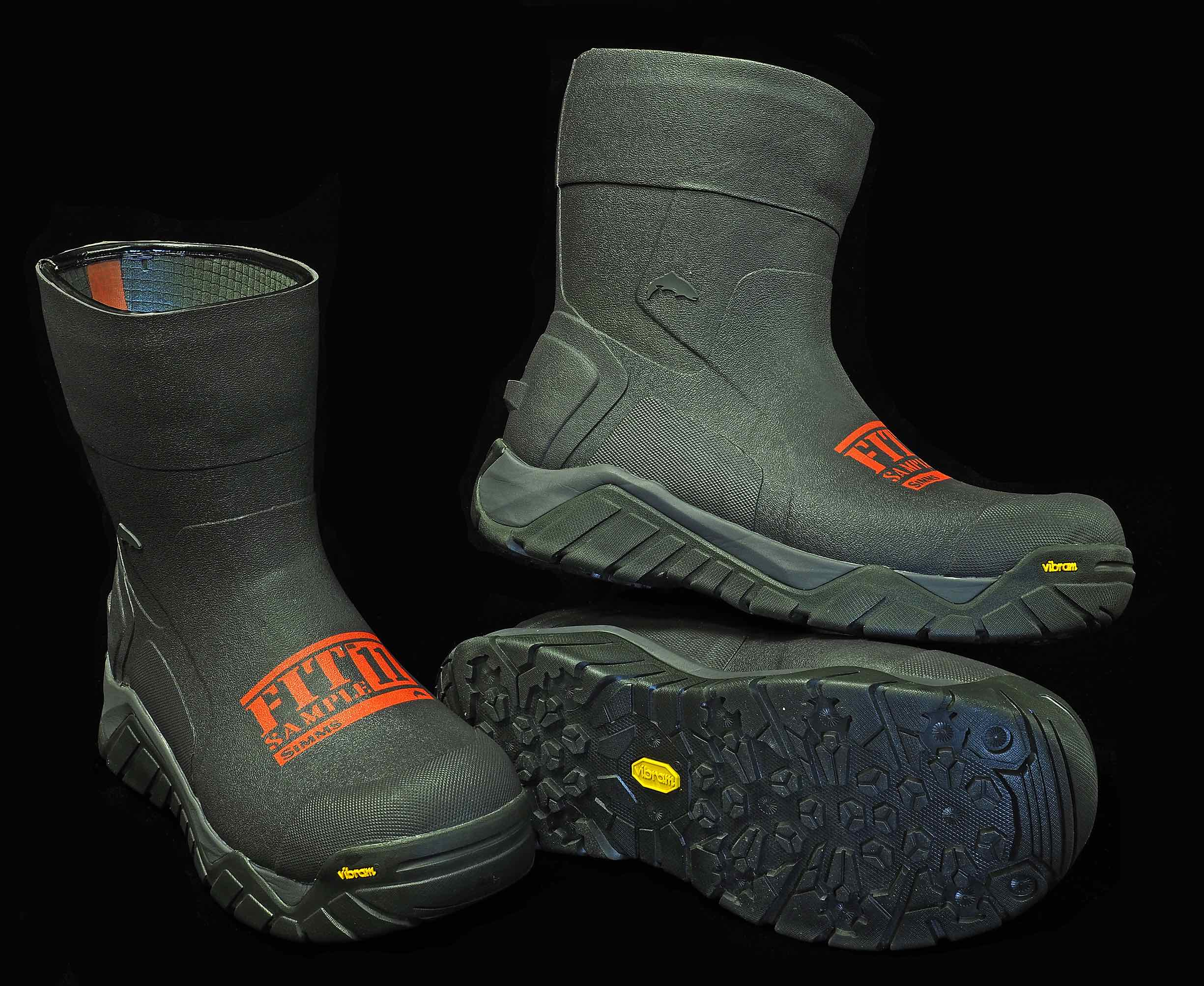 https://hooklineandsinker.ca/wp-content/uploads/2017/09/2017-Simms-Vibram-Boot-Fit-Kit-AA.jpg
2007
2450
HLSAdmin
https://hooklineandsinker.ca/wp-content/uploads/2014/12/Steelheading-in-the-Snow-900-80-Not-Faded-Actual-1030x91.jpg
HLSAdmin2017-09-02 23:20:492018-12-02 00:28:39Simms Vibram Boot Fit Kit
https://hooklineandsinker.ca/wp-content/uploads/2017/09/2017-Simms-Vibram-Boot-Fit-Kit-AA.jpg
2007
2450
HLSAdmin
https://hooklineandsinker.ca/wp-content/uploads/2014/12/Steelheading-in-the-Snow-900-80-Not-Faded-Actual-1030x91.jpg
HLSAdmin2017-09-02 23:20:492018-12-02 00:28:39Simms Vibram Boot Fit Kit https://hooklineandsinker.ca/wp-content/uploads/2016/06/Baitcast-professional-over-run-A.jpg
1616
1685
HLSAdmin
https://hooklineandsinker.ca/wp-content/uploads/2014/12/Steelheading-in-the-Snow-900-80-Not-Faded-Actual-1030x91.jpg
HLSAdmin2016-06-11 23:21:412019-07-24 18:56:04Baitcasting Lessons – Using a Baitcaster 101
https://hooklineandsinker.ca/wp-content/uploads/2016/06/Baitcast-professional-over-run-A.jpg
1616
1685
HLSAdmin
https://hooklineandsinker.ca/wp-content/uploads/2014/12/Steelheading-in-the-Snow-900-80-Not-Faded-Actual-1030x91.jpg
HLSAdmin2016-06-11 23:21:412019-07-24 18:56:04Baitcasting Lessons – Using a Baitcaster 101 https://hooklineandsinker.ca/wp-content/uploads/2015/06/Custom-Feathered-Treble-Hooks-AA.jpg
1339
2198
HLSAdmin
https://hooklineandsinker.ca/wp-content/uploads/2014/12/Steelheading-in-the-Snow-900-80-Not-Faded-Actual-1030x91.jpg
HLSAdmin2015-06-18 22:51:202017-12-23 22:20:15Custom Feathering
https://hooklineandsinker.ca/wp-content/uploads/2015/06/Custom-Feathered-Treble-Hooks-AA.jpg
1339
2198
HLSAdmin
https://hooklineandsinker.ca/wp-content/uploads/2014/12/Steelheading-in-the-Snow-900-80-Not-Faded-Actual-1030x91.jpg
HLSAdmin2015-06-18 22:51:202017-12-23 22:20:15Custom Feathering https://hooklineandsinker.ca/wp-content/uploads/2014/04/HLS-and-TFC-T-Shirts-AA.jpg
2198
1946
Ray Collesso
https://hooklineandsinker.ca/wp-content/uploads/2014/12/Steelheading-in-the-Snow-900-80-Not-Faded-Actual-1030x91.jpg
Ray Collesso2014-04-04 13:09:542017-02-12 18:57:59Custom Logo T-Shirts, Ball Caps, Hats & Much More…
https://hooklineandsinker.ca/wp-content/uploads/2014/04/HLS-and-TFC-T-Shirts-AA.jpg
2198
1946
Ray Collesso
https://hooklineandsinker.ca/wp-content/uploads/2014/12/Steelheading-in-the-Snow-900-80-Not-Faded-Actual-1030x91.jpg
Ray Collesso2014-04-04 13:09:542017-02-12 18:57:59Custom Logo T-Shirts, Ball Caps, Hats & Much More… https://hooklineandsinker.ca/wp-content/uploads/2014/01/Spey-Head-Loaner-Program-Airflo-AA.jpg
1528
2198
Ray Collesso
https://hooklineandsinker.ca/wp-content/uploads/2014/12/Steelheading-in-the-Snow-900-80-Not-Faded-Actual-1030x91.jpg
Ray Collesso2014-01-08 11:35:152022-04-18 13:28:29Spey Head Loaner Program (Airflo / RIO / OPST / Scientific Anglers)
https://hooklineandsinker.ca/wp-content/uploads/2014/01/Spey-Head-Loaner-Program-Airflo-AA.jpg
1528
2198
Ray Collesso
https://hooklineandsinker.ca/wp-content/uploads/2014/12/Steelheading-in-the-Snow-900-80-Not-Faded-Actual-1030x91.jpg
Ray Collesso2014-01-08 11:35:152022-04-18 13:28:29Spey Head Loaner Program (Airflo / RIO / OPST / Scientific Anglers) https://hooklineandsinker.ca/wp-content/uploads/2013/12/Fly-Line-Welding-Repair-Machine-Sage-6010-Fly-Reel-AAA.jpg
2070
2448
Ray Collesso
https://hooklineandsinker.ca/wp-content/uploads/2014/12/Steelheading-in-the-Snow-900-80-Not-Faded-Actual-1030x91.jpg
Ray Collesso2013-12-30 23:35:552022-03-18 22:36:39Airflo Line Welding & Repair Machine – SERVICE DISCONTINUED.
https://hooklineandsinker.ca/wp-content/uploads/2013/12/Fly-Line-Welding-Repair-Machine-Sage-6010-Fly-Reel-AAA.jpg
2070
2448
Ray Collesso
https://hooklineandsinker.ca/wp-content/uploads/2014/12/Steelheading-in-the-Snow-900-80-Not-Faded-Actual-1030x91.jpg
Ray Collesso2013-12-30 23:35:552022-03-18 22:36:39Airflo Line Welding & Repair Machine – SERVICE DISCONTINUED. https://hooklineandsinker.ca/wp-content/uploads/2017/01/mudhole-logo.jpg
181
192
HLSAdmin
https://hooklineandsinker.ca/wp-content/uploads/2014/12/Steelheading-in-the-Snow-900-80-Not-Faded-Actual-1030x91.jpg
HLSAdmin2017-01-15 17:21:162022-04-18 13:28:07Mud Hole Rod Building & Tackle Crafting
https://hooklineandsinker.ca/wp-content/uploads/2017/01/mudhole-logo.jpg
181
192
HLSAdmin
https://hooklineandsinker.ca/wp-content/uploads/2014/12/Steelheading-in-the-Snow-900-80-Not-Faded-Actual-1030x91.jpg
HLSAdmin2017-01-15 17:21:162022-04-18 13:28:07Mud Hole Rod Building & Tackle CraftingWe are the leading provider of Fly Fishing Lessons, Corporate Team Building, and Guiding on the Upper Grand River, the Upper Credit River, and the Conestogo River.
No Guelph, Fergus, Kitchener or Cambridge Fishing Tackle Retailer will boast as complete and diverse a store inventory, including a vast selection of Centerpin / Float Fishing Reels, Rods, Clothing and Accessories.
Order a HLS or TFC Gift Card – We will put one in the mail for FREE!
Fly Shop Flyshop Flyfish Grand River Fly fish Grand River Guide Grand River Lesson Grand River Fergus Ontario Canada


